- Speech Crafting →

Preparation: How to write a Speech Outline (with Examples)
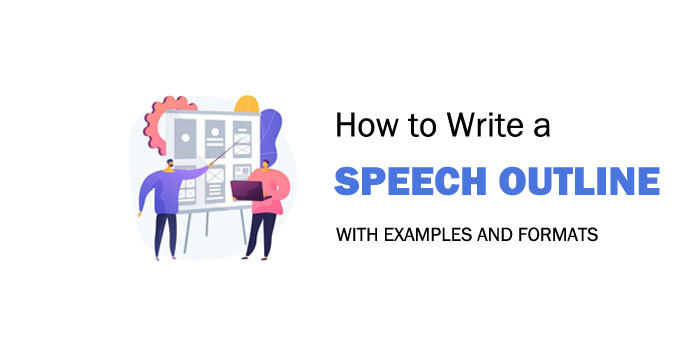
You have been chosen to give a speech on a particular topic and you reckon that you’re a good speech writer.
However, without a good speech outline, your speech lacks the proper skeleton to put meat on.
A speech outline is to a speech what a blueprint is to an unconstructed building.
So, how do you develop a good speech outline? First, break it down into small steps as this will make it easier for you to prioritize your ideas and organize them in the right order before you add more details to them.
How to Make an Outline for a Speech
Below are steps that will enable you to write an effective speech outline for your presentation.
You should start by asking yourself:
a) What is the big picture?
Before you begin writing your outline, you should take a step back and think about your speech as a whole.

First, think about the 3 keystones for your presentation or speech, i.e. the audience, your subject matter and of course, you, as the speaker.
Then, write a few notes down about each keystone and how they relate with each other. For instance,
- With regard to your presentation’s subject matter and the audience, what does the audience know about the subject? Do they find the subject interesting or not at all? Is the subject relevant to them?
- What do you as the speaker know about the subject in question? What are the reasons behind your presentation? Do you have any expertise on the matter? What new information will you be sharing with your audience?
A good outline will help you engage with your audience in a way that not only captures their attention but enables them to understand the subject matter.
b) What is your objective?
This refers to the goal of your presentation. Here, you should ask yourself, what do you want your audience to do after your presentation is over?

While the objective for most speakers is for their audience to know something, that may not be enough. The best presentations and speeches are those that move people to act.
If you would prefer to make an impact in such a way, then you should ensure that you are as specific as you can be when deciding on your objective in your speech outline.
c) What is your message?
Your message is what holds your presentation or speech together. This is not to mean that you shouldn’t have different parts in your speech, but it does mean that your speech should have one message that you are trying to put across.

Trying to include several different messages in your speech may confuse your audience, which makes it harder for them to understand the main point you are trying to convey.
To do this, summarize the message of your presentation in one statement. This will not only allow you to understand the message in its entirety but also allow you to explain the message to your audience in a way that is easy to understand.
You can now use the statement you wrote above to help you develop your speech outline. Using the statement to determine whether a certain point supports your main message will ensure that your speech flows and doesn’t include any information not relevant to your subject topic.
d) How is your presentation relevant?
When it comes to a presentation or speech, the audience should always come first. That is why as a speaker, you should always keep your audience in mind when presenting.
If you have already decided on the message you will be conveying to your audience, you should now ask yourself; how is your message relevant to the audience?

If you can’t come up with a reason why your presentation is relevant, then it’s back to the drawing board for you. This could mean that you will be presenting to the wrong audience or you will be giving the wrong presentation.
You can refer back to step (c) then review steps (a) and (b) for clarity.
e) Your speech structure
This is a very important part of your presentation as without it, your speech will have no impact on the audience. Therefore, you should ensure that you include the speech structure in your speech outline.
A structure has 3 basic parts; the introduction, the body and the conclusion. It should be noted though that when working on your speech outline, a common suggestion is to begin with the body before developing both your introduction and conclusion.

Under your speech structure, the introduction is the opening of your speech/presentation. To make a good first impression on your audience, ensure that your introduction is strong.
This doesn’t have to be the usual, “Good morning, my name is YXZ…” Instead, capture your audience’s attention by either telling a story or an interesting fact, recite a quote, ask your audience to recall or imagine something or even ask a rhetorical question!
Related: How to Start a Speech to Engage Your Audience
The body of your presentation represents the bulk of your speech. You should therefore ensure that your main points can be explained in detail and that they have been organized in a logical order that makes your message easy to comprehend.
Similar to your introduction, you should finish on a strong note when it comes to your conclusion. You can do this by linking your conclusion to your introduction, after which you can then echo and summarize your message’s main points.
Different Speech Outline Examples
Below are a few examples of different speech outlines that you can use as a basis to write your own outline. Choosing the right one that works for you may depend on the type of speech you will be giving .
1. Persuasive Speech Outline
Persuasive presentations and speeches usually have a specific purpose in mind; either to urge the audience to take action on something or persuade them to adopt a certain view or opinion of something.

This type of outline allows you, the speaker, to focus on the subject matter point while arguing your case in the most effective and compelling way to your audience.
A persuasive speech outline is made up of these parts:
- An introduction
- The conclusion
- Source Citation
The first three parts are common in most if not all presentations; please refer to step (e) to familiarize yourself with them once more.
A source citation is simply citing the sources for the research and facts that you presented in your speech. Remember you are trying to persuade your audience, so authoritative sources add weight to your argument.
2. Informative Speech Outline
There are different types of informative outlines. These include:
- The informative speech outline
- The informative presentation outline
- The informative essay outline
These outlines are made up of 3 basic parts; the introduction, body and conclusion. For purposes of this article, we will be discussing the informative speech outline.
The central objective of an informative speech is to offer unique, useful and interesting information to your audience. Before choosing your informative speech topic , you should consider your overall objective.

Additionally, there are various types of informative speeches , including:
- Concept - These are used to discuss abstract ideas like ideas and theories.
- Process - These are used when describing broad processes.
- Event - These are used to explain things that may happen, are already happening or those that have happened already.
- Object - These are used when talking about products, places or people.
In addition to this, there are patterns that can be used to organize your speech outline. These will be chosen depending on your speech type.
Types of these patterns include:
- Chronological or sequential - This pattern deals with a sequence of events; which could be useful in demonstration speeches or when discussing historical topics
- Spatial or geographic - Use this pattern when discussing topics that deal with physical spaces
- Logical - This pattern is suitable for a broad topic that has been broken down into sub-topics.
- Advantage-disadvantage - This pattern can be used when you will be examining a range of negative and positive aspects of an event or idea
Furthermore, there are 2 possibilities for preparing a speech outline; the speaking and preparation outline.
The speaking outlines make use of phrases and keywords, which helps keep you focused on the subject matter while the preparation outline is used to help you develop your speech and makes use of full sentences.
3. Demonstrative Speech Outline
A demonstrative speech is an instructional speech that teaches the audience something by demonstrating the process.

Here are the basic steps for a demonstrative speech:
- Ask yourself why you choose this topic and why it is important to the audience
- Provide an overview
- Explain the steps involved in your process
- Talk about variations, other options
- Ensure you allot time for Q&A
- Give a brief summary
For a more in-depth guide on writing demonstrative speeches, click here .
Pro-Tip: Write down the specific purpose of your speech and your topic of discussion as you formulate your generic speech outline.
Conclusion: On Speech Outline Formats
As you become better at writing and delivering speeches, you will soon learn that the different outline formats described above aren’t mutually exclusive. Rather, situations often make it necessary to mix different formats.
What are you waiting for? Go out there and grow your confidence as a speech writer and speaker!
- Personal Development
- Sales Training
- Business Training
- Time Management
- Leadership Training
- Book Writing
- Public Speaking
- Live Speaker Training With Brian
- See Brian Speak
- Coaching Programs
- Become a Coach
- Personal Success
- Sales Success
- Business Success
- Leadership Success
How To Write A Speech Outline
Do you have a speech coming up soon, but don’t know where to start when it comes to writing it?
Don’t worry.
The best way to start writing your speech is to first write an outline.
While to some, an outline may seem like an unnecessary extra step — after giving hundreds of speeches in my own career, I can assure you that first creating a speech outline is truly the best way to design a strong presentation that your audience will remember.
Should I Write A Speech Outline?
You might be wondering if you should really bother with a preparation outline. Is a speaking outline worth your time, or can you get through by just keeping your supporting points in mind?
Again, I highly recommend that all speakers create an outline as part of their speechwriting process. This step is an extremely important way to organize your main ideas and all the various elements of your speech in a way that will command your audience’s attention.
Good public speaking teachers will agree that an outline—even if it’s a rough outline—is the easiest way to propel you forward to a final draft of an organized speech that audience members will love.
Here are a few of the biggest benefits of creating an outline before diving straight into your speech.
Gain More Focus
By writing an outline, you’ll be able to center the focus of your speech where it belongs—on your thesis statement and main idea.
Remember, every illustration, example, or piece of information you share in your speech should be relevant to the key message you’re trying to deliver. And by creating an outline, you can ensure that everything relates back to your main point.
Keep Things Organized
Your speech should have an overall organizational pattern so that listeners will be able to follow your thoughts. You want your ideas to be laid out in a logical order that’s easy to track, and for all of the speech elements to correspond.
An outline serves as a structure or foundation for your speech, allowing you to see all of your main points laid out so you can easily rearrange them into an order that makes sense for easy listening.
Create Smoother Transitions
A speaking outline helps you create smoother transitions between the different parts of your speech.
When you know what’s happening before and after a certain section, it will be easy to accurately deliver transitional statements that make sense in context. Instead of seeming like several disjointed ideas, the parts of your speech will naturally flow into each other.
Save Yourself Time
An outline is an organization tool that will save you time and effort when you get ready to write the final draft of your speech. When you’re working off of an outline to write your draft, you can overcome “blank page syndrome.”
It will be much easier to finish the entire speech because the main points and sub-points are already clearly laid out for you.
Your only job is to finish filling everything in.
Preparing to Write A Speech Outline
Now that you know how helpful even the most basic of speech outlines can be in helping you write the best speech, here’s how to write the best outline for your next public speaking project.
How Long Should A Speech Outline Be?
The length of your speech outline will depend on the length of your speech. Are you giving a quick two-minute talk or a longer thirty-minute presentation? The length of your outline will reflect the length of your final speech.
Another factor that will determine the length of your outline is how much information you actually want to include in the outline. For some speakers, bullet points of your main points might be enough. In other cases, you may feel more comfortable with a full-sentence outline that offers a more comprehensive view of your speech topic.
The length of your outline will also depend on the type of outline you’re using at any given moment.
Types of Outlines
Did you know there are several outline types? Each type of outline is intended for a different stage of the speechwriting process. Here, we’re going to walk through:
- Working outlines
- Full-sentence outlines
- Speaking outlines
Working Outline
Think of your working outline as the bare bones of your speech—the scaffolding you’re using as you just start to build your presentation. To create a working outline, you will need:
- A speech topic
- An idea for the “hook” in your introduction
- A thesis statement
- 3-5 main points (each one should make a primary claim that you support with references)
- A conclusion
Each of your main points will also have sub-points, but we’ll get to those in a later step.
The benefit of a working outline is that it’s easy to move things around. If you think your main points don’t make sense in a certain order—or that one point needs to be scrapped entirely—it’s no problem to make the needed changes. You won’t be deleting any of your prior hard work because you haven’t really done any work yet.
Once you are confident in this “skeleton outline,” you can move on to the next, where you’ll start filling in more detailed information.
Full-sentence outline
As the name implies, your full-sentence outline contains full sentences. No bullet points or scribbled, “talk about x, y, z here.” Instead, research everything you want to include and write out the information in full sentences.
Why is this important? A full-sentence outline helps ensure that you are:
- Including all of the information your audience needs to know
- Organizing the material well
- Staying within any time constraints you’ve been given
Don’t skip this important step as you plan your speech.
Speaking outline
The final type of outline you’ll need is a speaking outline. When it comes to the level of detail, this outline is somewhere in between your working outline and a full-sentence outline.
You’ll include the main parts of your speech—the introduction, main points, and conclusion. But you’ll add a little extra detail about each one, too. This might be a quote that you don’t want to misremember or just a few words to jog your memory of an anecdote to share.
When you actually give your speech, this is the outline you will use. It might seem like it makes more sense to use your detailed full-sentence outline up on stage. However, if you use this outline, it’s all too easy to fall into the trap of reading your speech—which is not what you want to do. You’ll likely sound much more natural if you use your speaking outline.
How to Write A Speech Outline
We’ve covered the types of outlines you’ll work through as you write your speech. Now, let’s talk more about how you’ll come up with the information to add to each outline type.
Pick A Topic
Before you can begin writing an outline, you have to know what you’re going to be speaking about. In some situations, you may have a topic given to you—especially if you are in a public speaking class and must follow the instructor’s requirements. But in many cases, speakers must come up with their own topic for a speech.
Consider your audience and what kind of educational, humorous, or otherwise valuable information they need to hear. Your topic and message should of course be highly relevant to them. If you don’t know your audience well enough to choose a topic, that’s a problem.
Your audience is your first priority. If possible, however, it’s also helpful to choose a topic that appeals to you. What’s something you’re interested in and/or knowledgeable about?
It will be much easier to write a speech on a topic you care about rather than one you don’t. If you can come up with a speech topic that appeals to your audience and is interesting to you, that’s the sweet spot for writing and delivering an unforgettable speech.
Write A Thesis Statement
The next step is to ask yourself two important questions:
- What do you want your audience to take away from your speech?
- How will you communicate this main message?
The key message of your speech can also be called your “thesis statement.”
Essentially, this is your main point—the most important thing you hope to get across.
You’ll most likely actually say your thesis statement verbatim during your speech. It should come at the end of your introduction. Then, you’ll spend the rest of your talk expanding on this statement, sharing more information that will prove the statement is true.
Consider writing your thesis statement right now—before you begin researching or outlining your speech. If you can refer back to this statement as you get to work, it will be much easier to make sure all of the elements correspond with each other throughout your speech.
An example of a good thesis statement might read like this:
- Going for a run every day is good for your health.
- It’s important to start saving for retirement early.
- The COVID-19 pandemic had a negative impact on many small businesses.
The second part of this step is to know how you will communicate your main message . For example, if your key point is that running improves physical health, you might get this across by:
- Citing scientific studies that proved running is good for your health
- Sharing your personal experience of going for a run every day
Your goal is for all of your sub-points and supporting material to reflect and support your main point. At the end of the speech, your audience should be appropriately motivated, educated, or convinced that your thesis statement is true.
Once you have a topic for your presentation and a good thesis statement, you can move on to the bulk of the outline.
The first part of your speech is the introduction, which should include a strong “hook” to grab the attention of your audience. There are endless directions you can go to create this hook. Don’t be afraid to get creative! You might try:
- Telling a joke
- Sharing an anecdote
- Using a prop or visual aid
- Asking a question (rhetorical or otherwise)
These are just a few examples of hooks that can make your audience sit up and take notice.
The rest of your introduction shouldn’t be too long—as a general rule of thumb, you want your introduction to take up about 10% of your entire speech. But there are a few other things you need to say.
Briefly introduce yourself and who you are to communicate why the audience should trust you. Mention why you’re giving this speech.
Explain that you’re going to cover X main points—you can quickly list them—and include your thesis statement.
You could also mention how long your speech will be and say what your audience will take away from it (“At the end of our 15 minutes together today, you’ll understand how to write a resume”).
Then smoothly transition into the body of your speech.
Next, you’ll write the body of your speech. This is the bulk of your presentation. It will include your main points and their sub-points. Here’s how this should look:
Your subpoints might be anecdotes, visual aids, or studies. However you decide to support your main points, make them memorable and engaging. Nobody wants to sit and listen to you recite a dry list of facts.
Remember, the amount of detail you include right now will depend on which outline you’re on. Your first outline, or working outline, doesn’t have to include every last little detail. Your goal is to briefly encapsulate all of the most important elements in your speech.
But beyond that, you don’t need to write down every last detail or example right now. You don’t even have to write full sentences at this point. That will come in your second outline and other future drafts.
Your conclusion should concisely summarize the main points of your speech. You could do this by saying, “To recap as I finish up, today we learned…” and reiterate those primary points.
It’s also good to leave the audience with something to think about and/or discuss. Consider asking them a question that expands on your speech—something they can turn over in their minds the rest of the day.
Or share one final story or quote that will leave them with lasting inspiration. Bonus points if your conclusion circles back around to your introduction or hook.
In other cases, you may want to end with a call to action. Are you promoting something? Make sure your audience knows what it is, how it will benefit them, and where they can find it. Or, your CTA might be as simple as plugging your Twitter handle and asking listeners to follow you.
Finally, don’t forget to say thank you to your audience for taking the time to listen.
Additional Helpful Speechwriting Tips
Your speech outline is important, but it’s not the only thing that goes into preparing to give a presentation. Take a look at these additional tips I recommend to help your speech succeed.
Use Visual Aids
Visual aids are a good way to make sure your audience stays engaged—that they listen closely, and remember what you said. Visual aids serve as an attention-getter for people who may not be listening closely. These aids also ensure that your points are sufficiently supported.
You might choose to incorporate any of the following in your talk:
- A PowerPoint presentation
- A chart or graph
- A whiteboard or blackboard
- A flip chart
- A prop that you hold or interact with
Don’t overdo it. Remember, your speech is the main thing you’re presenting. Any visual aids are just that—aids. They’re a side dish, not the main entrée. Select one primary type of aid for your speech.
If you decide to include visual aids, use your speaking outline to make a note of which items you will incorporate where. You may want to place these items on your working outline. They should definitely be on your full-sentence outline.
Keep Your Audience Engaged
As you write and practice your speech, make sure you’re doing everything you can to keep your audience engaged the entire time. We’ve already talked about including stories and jokes, using visual aids, or asking questions to vary your talk and make it more interesting.
Your body language is another important component of audience engagement. Your posture should be straight yet relaxed, with shoulders back and feet shoulder-width apart. Keep your body open to the audience.
Make eye contact with different people in the audience. Incorporate hand gestures that emphasize certain points or draw attention to your visual aids.
Don’t be afraid to move around whatever space you have. Movement is especially helpful to indicate a clearer transition from one part of your speech to another. And smile! A simple smile goes a long way to help your audience relax.
Practice Your Speech
When you’re done with speechwriting, it’s time to get in front of the mirror and practice. Pay attention to your body language, gestures, and eye contact.
Practice working with any visual aids or props you will be using. It’s also helpful to make a plan B—for instance, what will you do if the projector isn’t working and you can’t use your slides?
Ask a friend or family member if you can rehearse your speech for them. When you’re through, ask them questions about which parts held their attention and which ones didn’t.
You should also use your speaking outline and whatever other notes you’ll be using in your speech itself. Get used to referring to this outline as you go. But remember, don’t read anything verbatim (except maybe a quote). Your speaking outline is simply a guide to remind you where you’re going.
Learn to Speak Like A Leader
There’s a lot of work that goes into writing a speech outline. That’s undeniable. But an outline is the best way to organize and plan your presentation. When your speech outline is ready, it will be a breeze to write and then present your actual speech.
If you’re looking for more help learning how to become a strong public speaker, I recommend my free 5 Minute Speech Formula . This will help you start writing your speech and turn any idea into a powerful message.
« Previous Post Productivity Tips – Be More Productive With Less Effort Next Post » How To Communicate Effectively In Any Situation
About Brian Tracy — Brian is recognized as the top sales training and personal success authority in the world today. He has authored more than 60 books and has produced more than 500 audio and video learning programs on sales, management, business success and personal development, including worldwide bestseller The Psychology of Achievement. Brian's goal is to help you achieve your personal and business goals faster and easier than you ever imagined. You can follow him on Twitter , Facebook , Pinterest , Linkedin and Youtube .
- Most Recent
- How to Write a Book: Proven Start-to-Finish Steps
- 117 Leadership Quotes for Inspiration
- 7 Tips for Writing Motivation: Stay Motivated When Writing a Book
- How to End a Speech: What You Need for a Bang
- Goal Setting for Success & Developing SMART Habits
- Free Webinar: How To Write a Book and Become a Published Author
- Free Video Series: 3-Part Sales Mastery Training Series
- Free Assessment: The Confidence Factor
- Free Assessment: Discovering Your Talents
Browse Categories
- Financial Success
Follow Brian & Join the Discussion
- Free Resources
- Best Sellers
- Knowledge Base
- Shipping & Returns
- Privacy Policy
- About Brian
- Brian Recommends
Your Privacy is Guaranteed. We will never give, lease or sell your personal information. Period!
© Copyright 2001-2024 Brian Tracy International. All Rights Reserved.
- Speech Writing
- Delivery Techniques
- PowerPoint & Visuals
- Speaker Habits
- Speaker Resources
- Speech Critiques
- Book Reviews
- Browse Articles
- ALL Articles
- Learn About Us
- About Six Minutes
- Meet Our Authors
- Write for Us
- Advertise With Us
Speech Preparation #3: Don’t Skip the Speech Outline
This article describes how to support your core message with a speech outline , and provides numerous examples . This is the second step in the six-step speech preparation process .
Writing an outline is, unfortunately, a step that many skip. The most common excuse is simply “ No time. ” This is unfortunate because time spent on an outline is time well spent. It is necessary to ensure that you craft a coherent and focussed presentation .
- How to Prepare Your Presentation
- Select Your Speech Topic
- Plan Your Speech Outline
- Writing Your First Draft
- Editing Your Speech
- Add Speech Impact with Rhetorical Devices
- Staging, Gestures, and Vocal Variety
- Practicing Your Presentation
- Self-Critique: Preparation for Next Time
- Winning a Toastmasters Speech Contest
Writing a Speech Outline
- Basic Speech Outline
- Speech Outline Variants
- Outline Writing Tips
- Speech Outline Extended Example
An outline is a blueprint for your presentation .
- It highlights the key logical elements . i.e. what points are being made to logically support the core message?
- It highlights the key structural elements . e.g. introduction, body, conclusion, stories, high-level concepts
- It links these elements together in a sequence , perhaps allocating very rough timings.
- It can also map out the transitions between elements , although this may be deferred to a later stage of preparation.
Basic Speech Outlines
“ An outline is a blueprint for your presentation. ”
The basic speech outline template for structural elements is:
- Introduction
Similarly, the basic speech outline template for logical elements is the familiar advice:
- Tell them what you’re going to say
- Tell them what you’ve said
Put these together, and you have the start of a generic speech outline :
- Introduction — Establish topic and core message; list supporting points
- Supporting Point One
- Supporting Point Two
- Supporting Point Three
- Conclusion — Recap main points; summarize core message; call-to-action
It is surprising how well this simple 3-part outline template works for a wide range of speech topics. Incidentally, this same basic formula can be seen in novels, short stories, movies, plays, reports, business briefings, emails, memos, and many other forms of communication.
For many more examples , check out Why Successful Speech Outlines follow the Rule of Three .
Variants or Examples of Speech Outlines
Example: story-based outline.
Some people believe that stories are the best building blocks for speeches. For example, in The Story Factor (Annette Simmons) , the author claims that storytelling is the key to business communications .
- Attention grabbing opening which introduces the topic and core message
- Make a point
- Make another point.
- Make another point
- Memorable conclusion which ties together all three stories to support the core message.
Example: Scientific Conference Talk Outline
The outline for many scientific talks mirrors the scientific method :
- Define the problem needing a solution
- Describe the hypothesis which will explore one aspect of the problem
- Detail 1 — schematic
- Detail 2 — photograph
- Detail 3 — description
- Data analysis 1 — chart
- Data analysis 2 — chart
- Data analysis 3 — table
- Draw conclusions relating back to the hypothesis
- Suggest future actions
Example: Community Association Meeting Speech Outline
- Story to introduce the symptom (e.g. vandalism)
- Stakeholders
- A strong call-to-action motivating the audience to join the cause
Example: Business Proposal to Investors
- Be direct: “Invest $___ for %___ of the shares”
- Story to illustrate the need for the product XYZ
- Story to describe the vision of how product XYZ improves lives
- Benefit #1 (focus on benefits, not features)
- Story illustrating strength of the team
- Market analysis
- Financial projections
- Repeat call-to-action: “Invest $___ for %___ of the shares”
Other Speech Outline Writing Tips
“ When sequencing your outline points, try to avoid random order. Seek and extract the meaningful relationship. ”
Note that all of these speech outline examples are appropriate for a short six to ten minute speech . Longer time windows will obviously allow for more detailed outlines.
You may be able to customize one of the generic speech outline formats for your speech; more likely, you will need to craft your own to fit your situation. A few other things to consider:
- The granularity of your outline should be roughly one outline point per minute of speaking time, perhaps less for lengthy presentations.
- Remember that your presentation is much more than your set of slides . Your outline should reflect your speaking elements which the slides complement.
- Chronological – e.g. a biographical speech
- Spatial – e.g. an entertaining travel speech
- Cause-effect – e.g. speech relating crime rate to drug use
- Low to high importance – e.g. reasons to exercise
- Broad vision to specific details – e.g. a management speech outlining new company direction
- Your outline is not the same as cue cards , but they are related (if you use cue cards). An outline contains high-level speech elements; cue cards might additionally contain selected speech details e.g. transition phrases, key words/phrases, key numbers, or punch lines.
Speech Outline Example — Face the Wind
Here is the original outline that I put together for the Face the Wind speech. Comments follow which represent my thinking at the time of writing the outline.
- Opening humor – connect with audience as typical home owner
- “Strong roots… strong tree”
- Foreshadow: neighbour’s monster tree falling
- National news (trees falling on houses), but our house okay
- Arborists: “Wind came from a different direction”
- Establish key analogy – Trees cannot face the wind.
- Michelle and Lance have strong roots
- Maximus is born
- Call-to-action: “We must face our problems”
Comments on Face the Wind Outline
At the outline stage, I set up many key elements of the speech. I determined the three main stories, planned humorous opening, identified a few key phrases to incorporate, established contrast (tree/people), used a metaphor (roots of people), and concluded with a call-to-action.
Opening – I wanted to open with humor to offset the drama later in the speech. Also, I wanted to connect with the audience as a homeowner as many in the audience are also homeowners.
Story #1 – I wanted the first story to establish the “strong roots… strong tree” connection. By establishing that trees have strong roots, it makes the fact that they were toppled in the storm (story #2) more dramatic.
Story #2 – This story was essentially an expansion of the “wind came from a different direction” theory of arborists that I picked up several months prior from my friend. The fact that trees cannot face the wind is the key analogy in this speech, although the audience doesn’t know it yet.
Story #3 – This story tells about the struggles which eventually led to the birth of Maximus. The key element here is the contrast between trees and people (who can face the wind).
Next in the Speech Preparation Series
The next article in this series discusses the causes of writer’s block and writing the first draft of your speech .
Please share this...
This is one of many public speaking articles featured on Six Minutes . Subscribe to Six Minutes for free to receive future articles.
Add a Comment Cancel reply
E-Mail (hidden)
Subscribe - It's Free!
| Follow Us |
Similar Articles You May Like...
- How to Sequence Your Presentation
- How to Master the Demonstration Speech
- How Many Slides Should You Have? How Many Slides Do You Need?
- Speech Analysis: Gettysburg Address – Abraham Lincoln
- Why Successful Speech Outlines follow the Rule of Three
- 5 Speechwriting Lessons from Obama’s Inaugural Speech
Find More Articles Tagged:
11 comments.
Andrew, I can’t imagine not using an outline! In fact, for most of my presentations, I ONLY write an outline and use just that for all of my preparation. Can’t have a body without a skeleton!
Hi Lisa I am a student at Ashworth University. I love that school. I received my Associate in Criminal Justice, and now working on my Bachelor in Early Childhood Development. My Bachelor is online and it is kicking me Real Hard! lol I truly wish I had the confident you have about the outline. I have about 30 sheets of papers in front of me and I have NO ideal of where to start!
Thanks, good information. I needed a refresher on some of this information. Much appreciated. 🙂
i think to have a speach outline can help in the long run!!
This is an extremely good article which helps me a lot!
I am one of the students of CST 100 at Northern Virginia community college Annandale campus.
Writing an outline is such as good help. It helps me to underline all the points that I am going to say, and also it helps me not to focus on my notes so that I can make a great eye contact with my audiences. My speech goes smoothly when I do my outline before that.
Thank you for sharing! Great information to build a speech that will impact listeners. I quill share your page with others!
Fantastic resource. I suggest it to students all the time.
This was a very helpful article. Thank you. I give my second speech tomorrow. I hope to execute all you have taught us.
Very helpful!:)
Awesome Article. Definitely great starter points for anyone wanting to write a speech. I have been stuck on my speech writing and now I feel more confident in progressing forward.
Recent Tweets
Speech Preparation #3: Don't Skip the Speech Outline http://t.co/tddYaIe4 via @6minutes — Ms. Petrini Dec 29th, 2012
This article teaches you how to quickly outline your next speech. #speaking http://t.co/bSZLbOD23U — @blazelazarony Feb 10th, 2014
In public speaking, creating an outline is a vital step. Here are some tips to give you a hand http://t.co/1qq1SzU6iw — @EIU_CMN_1310 Sep 30th, 2015
So you’ve settled on a topic, and it’s something that you are passionate about, you know the ins and outs of the… https://t.co/0HBAWaL4a8 — R/Hm Toastmasters WA (@RHmToastmasters) Jan 5th, 2016
Speech Preparation: Speech Outline Examples https://t.co/HV5cxk7EQX by @6minutes — @ashokqs Feb 7th, 2016
https://t.co/08ZrGXfrl4 — @YoYoManojKumar2 Mar 5th, 2016
Speech Preparation #3: Don’t Skip the Speech Outline https://t.co/aw0vZrsuRY by @6minutes — @touriiy Jan 30th, 2017
Speech Preparation: Speech Outline Examples https://t.co/jeX0WpDISy by @6minutes #Toastmasters #publicspeaking #prepared — @ClaudiaLeBaron Apr 25th, 2017
Don’t skip the speech outline! https://t.co/dnMuvCBMbz #CYSA17 #SpeakingUpforAg #publicspeaking — CYSA (@CYSAgriculture) Jul 11th, 2017
Speech Preparation #3: Don’t Skip the Speech Outline https://t.co/cvGT2B2WjO by @6minutes — @ShlokamS Jan 30th, 2019
8 Blog Links
S.O.A.P.S. Activity « Mrs. Henson’s Blog — Mar 13th, 2009
Speech Preparation « Mrs. Henson’s Blog — Sep 15th, 2009
3 simple ways to improve your public speaking « Low Hanging Fruit — Nov 12th, 2009
Public Speaking Training — Dec 22nd, 2009
Potential Speech Formats « Space/Place/Identity/Affect — Sep 4th, 2012
Speech Preparation | Managerial Communication Everyday — Sep 25th, 2012
PowerPoint Presentations - what NOT to write | English Editing Blog — Nov 21st, 2012
Prepare that speech | E-WOT — Apr 28th, 2013
| [ ] | [ ] | [ ] |
| [ ] | [ ] | [ ] |
| [ ] | [ ] | [ ] |
| Follow Six Minutes |
Six Minutes Copyright © 2007-2022 All Rights Reserved.
Read our permissions policy , privacy policy , or disclosure policy .
Comments? Questions? Contact us .
- Games, topic printables & more
- The 4 main speech types
- Example speeches
- Commemorative
- Declamation
- Demonstration
- Informative
- Introduction
- Student Council
- Speech topics
- Poems to read aloud
- How to write a speech
- Using props/visual aids
- Acute anxiety help
- Breathing exercises
- Letting go - free e-course
- Using self-hypnosis
- Delivery overview
- 4 modes of delivery
- How to make cue cards
- How to read a speech
- 9 vocal aspects
- Vocal variety
- Diction/articulation
- Pronunciation
- Speaking rate
- How to use pauses
- Eye contact
- Body language
- Voice image
- Voice health
- Public speaking activities and games
- Blogging Aloud
- About me/contact
How to write a good speech in 7 steps
By: Susan Dugdale
- an easily followed format for writing a great speech
Did you know writing a speech doesn't have be an anxious, nail biting experience?
Unsure? Don't be.
You may have lived with the idea you were never good with words for a long time. Or perhaps giving speeches at school brought you out in cold sweats.
However learning how to write a speech is relatively straight forward when you learn to write out loud.
And that's the journey I am offering to take you on: step by step.
To learn quickly, go slow
Take all the time you need. This speech format has 7 steps, each building on the next.
Walk, rather than run, your way through all of them. Don't be tempted to rush. Familiarize yourself with the ideas. Try them out.
I know there are well-advertised short cuts and promises of 'write a speech in 5 minutes'. However in reality they only truly work for somebody who already has the basic foundations of speech writing in place.
The foundation of good speech writing
These steps are the backbone of sound speech preparation. Learn and follow them well at the outset and yes, given more experience and practice you could probably flick something together quickly. Like any skill, the more it's used, the easier it gets.
In the meantime...
Step 1: Begin with a speech overview or outline
Are you in a hurry? Without time to read a whole page? Grab ... The Quick How to Write a Speech Checklist And come back to get the details later.
- WHO you are writing your speech for (your target audience)
- WHY you are preparing this speech. What's the main purpose of your speech? Is it to inform or tell your audience about something? To teach them a new skill or demonstrate something? To persuade or to entertain? (See 4 types of speeches: informative, demonstrative, persuasive and special occasion or entertaining for more.) What do you want them to think, feel or do as a result of listening the speech?
- WHAT your speech is going to be about (its topic) - You'll want to have thought through your main points and have ranked them in order of importance. And have sorted the supporting research you need to make those points effectively.
- HOW much time you have for your speech eg. 3 minutes, 5 minutes... The amount of time you've been allocated dictates how much content you need. If you're unsure check this page: how many words per minute in a speech: a quick reference guide . You'll find estimates of the number of words required for 1 - 10 minute speeches by slow, medium and fast talkers.
Use an outline
The best way to make sure you deliver a perfect speech is to start by carefully completing a speech outline covering the essentials: WHO, WHY, WHAT and HOW.
Beginning to write without thinking your speech through is a bit like heading off on a journey not knowing why you're traveling or where you're going to end up. You can find yourself lost in a deep, dark, murky muddle of ideas very quickly!
Pulling together a speech overview or outline is a much safer option. It's the map you'll follow to get where you want to go.
Get a blank speech outline template to complete
Click the link to find out a whole lot more about preparing a speech outline . ☺ You'll also find a free printable blank speech outline template. I recommend using it!
Understanding speech construction
Before you begin to write, using your completed outline as a guide, let's briefly look at what you're aiming to prepare.
- an opening or introduction
- the body where the bulk of the information is given
- and an ending (or summary).
Imagine your speech as a sandwich

If you think of a speech as a sandwich you'll get the idea.
The opening and ending are the slices of bread holding the filling (the major points or the body of your speech) together.
You can build yourself a simple sandwich with one filling (one big idea) or you could go gourmet and add up to three or, even five. The choice is yours.
But whatever you choose to serve, as a good cook, you need to consider who is going to eat it! And that's your audience.
So let's find out who they are before we do anything else.
Step 2: Know who you are talking to
Understanding your audience.
Did you know a good speech is never written from the speaker's point of view? ( If you need to know more about why check out this page on building rapport .)
Begin with the most important idea/point on your outline.
Consider HOW you can explain (show, tell) that to your audience in the most effective way for them to easily understand it.
Writing from the audience's point of view

To help you write from an audience point of view, it's a good idea to identify either a real person or the type of person who is most likely to be listening to you.
Make sure you select someone who represents the "majority" of the people who will be in your audience. That is they are neither struggling to comprehend you at the bottom of your scale or light-years ahead at the top.
Now imagine they are sitting next to you eagerly waiting to hear what you're going to say. Give them a name, for example, Joe, to help make them real.
Ask yourself
- How do I need to tailor my information to meet Joe's needs? For example, do you tell personal stories to illustrate your main points? Absolutely! Yes. This is a very powerful technique. (Click storytelling in speeches to find out more.)
- What type or level of language is right for Joe as well as my topic? For example if I use jargon (activity, industry or profession specific vocabulary) will it be understood?
Step 3: Writing as you speak
Writing oral language.
Write down what you want to say about your first main point as if you were talking directly to Joe.
If it helps, say it all out loud before you write it down and/or record it.
Use the information below as a guide

(Click to download The Characteristics of Spoken Language as a pdf.)
You do not have to write absolutely everything you're going to say down * but you do need to write down, or outline, the sequence of ideas to ensure they are logical and easily followed.
Remember too, to explain or illustrate your point with examples from your research.
( * Tip: If this is your first speech the safety net of having everything written down could be just what you need. It's easier to recover from a patch of jitters when you have a word by word manuscript than if you have either none, or a bare outline. Your call!)
Step 4: Checking tone and language
The focus of this step is re-working what you've done in Step 2 and 3.
You identified who you were talking to (Step 2) and in Step 3, wrote up your first main point. Is it right? Have you made yourself clear? Check it.

How well you complete this step depends on how well you understand the needs of the people who are going to listen to your speech.
Please do not assume because you know what you're talking about the person (Joe) you've chosen to represent your audience will too. Joe is not a mind-reader!
How to check what you've prepared
- Check the "tone" of your language . Is it right for the occasion, subject matter and your audience?
- Check the length of your sentences. You need short sentences. If they're too long or complicated you risk losing your listeners.
Check for jargon too. These are industry, activity or group exclusive words.
For instance take the phrase: authentic learning . This comes from teaching and refers to connecting lessons to the daily life of students. Authentic learning is learning that is relevant and meaningful for students. If you're not a teacher you may not understand the phrase.
The use of any vocabulary requiring insider knowledge needs to be thought through from the audience perspective. Jargon can close people out.
- Read what you've written out loud. If it flows naturally, in a logical manner, continue the process with your next main idea. If it doesn't, rework.
We use whole sentences and part ones, and we mix them up with asides or appeals e.g. "Did you get that? Of course you did. Right...Let's move it along. I was saying ..."
Click for more about the differences between spoken and written language .
And now repeat the process
Repeat this process for the remainder of your main ideas.
Because you've done the first one carefully, the rest should follow fairly easily.
Step 5: Use transitions
Providing links or transitions between main ideas.
Between each of your main ideas you need to provide a bridge or pathway for your audience. The clearer the pathway or bridge, the easier it is for them to make the transition from one idea to the next.

If your speech contains more than three main ideas and each is building on the last, then consider using a "catch-up" or summary as part of your transitions.
Is your speech being evaluated? Find out exactly what aspects you're being assessed on using this standard speech evaluation form
Link/transition examples
A link can be as simple as:
"We've explored one scenario for the ending of Block Buster 111, but let's consider another. This time..."
What follows this transition is the introduction of Main Idea Two.
Here's a summarizing link/transition example:
"We've ended Blockbuster 111 four ways so far. In the first, everybody died. In the second, everybody died BUT their ghosts remained to haunt the area. In the third, one villain died. His partner reformed and after a fight-out with the hero, they both strode off into the sunset, friends forever. In the fourth, the hero dies in a major battle but is reborn sometime in the future.
And now what about one more? What if nobody died? The fifth possibility..."
Go back through your main ideas checking the links. Remember Joe as you go. Try each transition or link out loud and really listen to yourself. Is it obvious? Easily followed?
Keep them if they are clear and concise.
For more about transitions (with examples) see Andrew Dlugan's excellent article, Speech Transitions: Magical words and Phrases .
Step 6: The end of your speech
The ideal ending is highly memorable . You want it to live on in the minds of your listeners long after your speech is finished. Often it combines a call to action with a summary of major points.

Example speech endings
Example 1: The desired outcome of a speech persuading people to vote for you in an upcoming election is that they get out there on voting day and do so. You can help that outcome along by calling them to register their support by signing a prepared pledge statement as they leave.
"We're agreed we want change. You can help us give it to you by signing this pledge statement as you leave. Be part of the change you want to see!
Example 2: The desired outcome is increased sales figures. The call to action is made urgent with the introduction of time specific incentives.
"You have three weeks from the time you leave this hall to make that dream family holiday in New Zealand yours. Can you do it? Will you do it? The kids will love it. Your wife will love it. Do it now!"
How to figure out the right call to action
A clue for working out what the most appropriate call to action might be, is to go back to your original purpose for giving the speech.
- Was it to motivate or inspire?
- Was it to persuade to a particular point of view?
- Was it to share specialist information?
- Was it to celebrate a person, a place, time or event?
Ask yourself what you want people to do as a result of having listened to your speech.
For more about ending speeches
Visit this page for more about how to end a speech effectively . You'll find two additional types of speech endings with examples.
Write and test
Write your ending and test it out loud. Try it out on a friend, or two. Is it good? Does it work?
Step 7: The introduction
Once you've got the filling (main ideas) the linking and the ending in place, it's time to focus on the introduction.
The introduction comes last as it's the most important part of your speech. This is the bit that either has people sitting up alert or slumped and waiting for you to end. It's the tone setter!
What makes a great speech opening?
Ideally you want an opening that makes listening to you the only thing the 'Joes' in the audience want to do.
You want them to forget they're hungry or that their chair is hard or that their bills need paying.
The way to do that is to capture their interest straight away. You do this with a "hook".
Hooks to catch your audience's attention
Hooks come in as many forms as there are speeches and audiences. Your task is work out what specific hook is needed to catch your audience.

Go back to the purpose. Why are you giving this speech?
Once you have your answer, consider your call to action. What do you want the audience to do, and, or take away, as a result of listening to you?
Next think about the imaginary or real person you wrote for when you were focusing on your main ideas.
Choosing the best hook
- Is it humor?
- Would shock tactics work?
- Is it a rhetorical question?
- Is it formality or informality?
- Is it an outline or overview of what you're going to cover, including the call to action?
- Or is it a mix of all these elements?
A hook example
Here's an example from a fictional political speech. The speaker is lobbying for votes. His audience are predominately workers whose future's are not secure.
"How's your imagination this morning? Good? (Pause for response from audience) Great, I'm glad. Because we're going to put it to work starting right now.
I want you to see your future. What does it look like? Are you happy? Is everything as you want it to be? No? Let's change that. We could do it. And we could do it today.
At the end of this speech you're going to be given the opportunity to change your world, for a better one ...
No, I'm not a magician. Or a simpleton with big ideas and precious little commonsense. I'm an ordinary man, just like you. And I have a plan to share!"
And then our speaker is off into his main points supported by examples. The end, which he has already foreshadowed in his opening, is the call to vote for him.
Prepare several hooks
Experiment with several openings until you've found the one that serves your audience, your subject matter and your purpose best.
For many more examples of speech openings go to: how to write a speech introduction . You'll find 12 of the very best ways to start a speech.
That completes the initial seven steps towards writing your speech. If you've followed them all the way through, congratulations, you now have the text of your speech!
Although you might have the words, you're still a couple of steps away from being ready to deliver them. Both of them are essential if you want the very best outcome possible. They are below. Please take them.
Step 8: Checking content and timing
This step pulls everything together.
Check once, check twice, check three times & then once more!
Go through your speech really carefully.
On the first read through check you've got your main points in their correct order with supporting material, plus an effective introduction and ending.
On the second read through check the linking passages or transitions making sure they are clear and easily followed.
On the third reading check your sentence structure, language use and tone.
Double, triple check the timing
Now go though once more.
This time read it aloud slowly and time yourself.
If it's too long for the time allowance you've been given make the necessary cuts.
Start by looking at your examples rather than the main ideas themselves. If you've used several examples to illustrate one principal idea, cut the least important out.
Also look to see if you've repeated yourself unnecessarily or, gone off track. If it's not relevant, cut it.
Repeat the process, condensing until your speech fits the required length, preferably coming in just under your time limit.
You can also find out how approximately long it will take you to say the words you have by using this very handy words to minutes converter . It's an excellent tool, one I frequently use. While it can't give you a precise time, it does provide a reasonable estimate.

Step 9: Rehearsing your speech
And NOW you are finished with writing the speech, and are ready for REHEARSAL .

Please don't be tempted to skip this step. It is not an extra thrown in for good measure. It's essential.
The "not-so-secret" secret of successful speeches combines good writing with practice, practice and then, practicing some more.
Go to how to practice public speaking and you'll find rehearsal techniques and suggestions to boost your speech delivery from ordinary to extraordinary.
The Quick How to Write a Speech Checklist
Before you begin writing you need:.
- Your speech OUTLINE with your main ideas ranked in the order you're going to present them. (If you haven't done one complete this 4 step sample speech outline . It will make the writing process much easier.)
- Your RESEARCH
- You also need to know WHO you're speaking to, the PURPOSE of the speech and HOW long you're speaking for
The basic format
- the body where you present your main ideas
Split your time allowance so that you spend approximately 70% on the body and 15% each on the introduction and ending.
How to write the speech
- Write your main ideas out incorporating your examples and research
- Link them together making sure each flows in a smooth, logical progression
- Write your ending, summarizing your main ideas briefly and end with a call for action
- Write your introduction considering the 'hook' you're going to use to get your audience listening
- An often quoted saying to explain the process is: Tell them what you're going to tell them (Introduction) Tell them (Body of your speech - the main ideas plus examples) Tell them what you told them (The ending)
TEST before presenting. Read aloud several times to check the flow of material, the suitability of language and the timing.

- Return to top
speaking out loud
Subscribe for FREE weekly alerts about what's new For more see speaking out loud

Top 10 popular pages
- Welcome speech
- Demonstration speech topics
- Impromptu speech topic cards
- Thank you quotes
- Impromptu public speaking topics
- Farewell speeches
- Phrases for welcome speeches
- Student council speeches
- Free sample eulogies
From fear to fun in 28 ways
A complete one stop resource to scuttle fear in the best of all possible ways - with laughter.

Useful pages
- Search this site
- About me & Contact
- Free e-course
- Privacy policy
©Copyright 2006-24 www.write-out-loud.com
Designed and built by Clickstream Designs
- PRO Courses Guides New Tech Help Pro Expert Videos About wikiHow Pro Upgrade Sign In
- EDIT Edit this Article
- EXPLORE Tech Help Pro About Us Random Article Quizzes Request a New Article Community Dashboard This Or That Game Happiness Hub Popular Categories Arts and Entertainment Artwork Books Movies Computers and Electronics Computers Phone Skills Technology Hacks Health Men's Health Mental Health Women's Health Relationships Dating Love Relationship Issues Hobbies and Crafts Crafts Drawing Games Education & Communication Communication Skills Personal Development Studying Personal Care and Style Fashion Hair Care Personal Hygiene Youth Personal Care School Stuff Dating All Categories Arts and Entertainment Finance and Business Home and Garden Relationship Quizzes Cars & Other Vehicles Food and Entertaining Personal Care and Style Sports and Fitness Computers and Electronics Health Pets and Animals Travel Education & Communication Hobbies and Crafts Philosophy and Religion Work World Family Life Holidays and Traditions Relationships Youth
- Browse Articles
- Learn Something New
- Quizzes Hot
- Happiness Hub
- This Or That Game
- Train Your Brain
- Explore More
- Support wikiHow
- About wikiHow
- Log in / Sign up
- Education and Communications
- Communication Skills
- Public Speaking
- Speechwriting
How to Write a Speech Outline
Last Updated: May 23, 2024 Fact Checked
This article was co-authored by Emily Listmann, MA and by wikiHow staff writer, Jennifer Mueller, JD . Emily Listmann is a Private Tutor and Life Coach in Santa Cruz, California. In 2018, she founded Mindful & Well, a natural healing and wellness coaching service. She has worked as a Social Studies Teacher, Curriculum Coordinator, and an SAT Prep Teacher. She received her MA in Education from the Stanford Graduate School of Education in 2014. Emily also received her Wellness Coach Certificate from Cornell University and completed the Mindfulness Training by Mindful Schools. This article has been fact-checked, ensuring the accuracy of any cited facts and confirming the authority of its sources. This article has been viewed 509,792 times.
A speech outline can increase your confidence and help you keep your place so you sound authoritative and in control. As you write your speech outline, focus on how you'll introduce yourself and your topic, the points you'll cover, and the interests of your audience.
Sample Outline and Writing Help

Crafting Your Introduction

- Keep in mind you may be nervous when you start your speech. Include this in your outline so you won't forget.
- If there's anything about you that relates you to your audience, or to the group that organized the event, you want to include that in your brief greeting as well – especially if you didn't have the benefit of an introduction from someone else.
- For example, you might say "Good afternoon. I'm Sally Sunshine, and I've been a volunteer with the Springfield Animal Society for five years. I'm honored they've invited me to speak here today about the importance of spaying or neutering your pets."

- When choosing your attention-getter, keep your audience in mind. Think about what would grab their attention – not necessarily what you personally find interesting or humorous.
- If you're not sure whether your attention-getter will work, try practicing it in front of friends or family members who are similar in age and interests to the people who will be in the audience when you give your speech.
- For example, if you're giving a speech on spaying and neutering pets to a group of suburban families, you might open with a humorous reference to the Disney movie "101 Dalmatians."

- Briefly explain the importance of the topic or issue you'll be discussing in your speech.
- If your speech is an informative one, explain why the information is important or relevant to your audience.
- For argumentative speeches, explain what might happen if action isn't taken on the issue.
- For example, you might say "Every year, our local animal shelter has to put down 500 unwanted cats and dogs. If all pets were spayed and neutered, it's estimated this number would decrease to under 100."

- If you're giving an argumentative speech, your thesis statement will be a statement of the ultimate point you hope to prove through the information and evidence you lay out in your speech.
- For example, the thesis statement for a speech arguing that all pet owners should spay or neuter their pets might be "Our entire community would benefit if all pets were spayed or neutered."
- The thesis statement for a more informative speech will simply summarize the type of information you're going to provide the audience through your speech.
- For a more scientific speech, your thesis statement will reflect the hypothesis of the scientific study you're presenting in your speech.

- If you're giving a speech for a class in school, your "credibility" may be as simple as the fact that you took the class and researched the topic.
- However, if you have a more personalized interest in the topic of your speech, this is a good time to mention that.
- For an argumentative speech, a personal connection to the subject matter can enhance your credibility. For example, maybe you're giving a speech about local urban housing policy and you became interested in the topic when you learned your family was facing eviction. A personal connection often can mean more to members of your audience than extensive professional experience in the area.

- There's no hard and fast rule, but speeches typically have three main points. You should list them in your introduction in the order you plan to present them in your speech. The order in which you discuss your points depends on the type of speech you're giving.
- For example, your speech on spaying or neutering pets might address the benefits to the pet first, then the benefit to the pet's family, then the benefit to the community at large. This starts small and moves outward.
- For an argumentative speech, you typically want to lead with your strongest argument and work down in order of strength.
- If you're giving an informative speech based on a historical event, you may want to provide your points chronologically. Other informative speeches may be better served by starting with the broadest point and moving to more narrow points.
- Ultimately, you want to order your points in a way that feels natural to you and will enable you to easily transition from one point to another.
Building the Body of Your Speech

- Your first point will be a top-level entry on your outline, typically noted by a Roman numeral.
- Beneath that top-level, you will have a number of sub-points which are comments, statistics, or other evidence supporting that point. Depending on how your outline is formatted, these typically will be letters or bullet points.

- As with the points themselves, with your evidence you typically want to start with the strongest or most important sub-point or piece of evidence and move down. This way, if you start running short on time, you can easily cut the last points without worrying that you're leaving out something important.
- The type of evidence or sub-points you'll want to include will depend on the type of speech you're giving.
- Try to avoid pounding your audience with long series of numbers or statistics – they typically won't retain the information. If you have a significant amount of numerical data or statistics, creating an infographic you can project during your presentation may be more useful.
- Keep in mind that additional personal stories or anecdotes can be particularly effective to get your point across in a speech.
- For example, if your first point in your speech about spaying or neutering pets is that the procedure benefits the pets themselves, you might point out that pets that are spayed or neutered live longer, are at a decreased risk for certain types of cancer, and are generally more healthy than pets who aren't spayed or neutered.

- Avoid over-thinking your transition. It really doesn't need to be incredibly sophisticated. If you can't come up with anything specific, using a simple transitional phrase will work fine.
- For example, you might say "Now that I've discussed how spaying and neutering has a positive effect on your pet's health, I want to move to the effect that spaying and neutering has on your family."
- Some of the most effective transitions turn on a particular word or phrase, such as the word "effect" in the example above.

- When choosing your sub-points or the facts that you want to emphasize in your speech, keep your audience in mind as well as the overall point. Think about what's important to them, or what they potentially would find most surprising or most interesting.
Creating Your Closing

- This transition doesn't need to be fancy – it doesn't even have to be a whole sentence. You can simply say "In conclusion," and then launch into your summary.

- You don't need to go into detail here – you're just reinforcing what you've already told your audience.
- Make sure you don't introduce any new information in your closing summary.
- For example, you might say "As you've seen, spaying or neutering your pet has substantial benefits not only for you and your pet, but also for the community at large."

- If your speech went well, you have fully proven your thesis and demonstrated its importance. This statement should relate back to the summary of your points and present a strong statement.
- Particularly for brief speeches, you can even combine your summary of points with your thesis statement in a single sentence that wraps up your speech.
- For example, you might say "Given the benefits to your pet's health, to your family, and to the overall well-being of your community, it is clear that spaying or neutering pets should be a top priority for all pet owners."

- You may want to think of a way to bring the entire speech back around to that story you initially told to grab your audience's attention.
- If you have an argumentative or similar speech, your closing lines typically will include a call to action. Give your audience an example of how important the subject of your speech is, and implore them to act on the information you gave them in a specific way.
- When making a call to action, make sure you include specific details, such as where to go, who to contact, and when to act.
- For example, you might say "For the next week, the Springfield Animal Society will be spaying and neutering pets for free at their clinic on 123 Main Street. Call 555-555-5555 to make an appointment for your furry friend today!"

- Particularly if your speech was longer or if you went over the time allotted, be sure to tell them that you appreciate their time.
- As with your initial greeting, including this in your outline ensures you won't forget it in the moment. That doesn't mean you should try to write something verbatim. Rather, you should focus on your thanks being more off-the-cuff and sincere.

- If you want to establish parameters for the questions, be sure to list these in your outline so you can mention them when you announce that you're open for questions.
- Anticipate questions that may be asked dependent on your speech topic. Preemptively answer those questions and include them in your outline.
- You also should note if you only have a specified period of time for questions, or if you're only taking a set number of questions.
Community Q&A
- Outlines can vary in how formal or informal you make them. You could either make it a full script or use shorthand with highlighted main points. Use the outline that works best for you. Thanks Helpful 12 Not Helpful 0
- Use a large font that you can easily read by glancing down. Print your outline and place it on a desk, then stand and look down at the paper. If it's too small or you find yourself leaning over to read it, increase the font size. Thanks Helpful 16 Not Helpful 3
- Type your outline on a word-processing application. There typically will be an outline template you can use that will format the outline correctly automatically. Thanks Helpful 7 Not Helpful 3

You Might Also Like

- ↑ https://www.unr.edu/writing-speaking-center/student-resources/writing-speaking-resources/speech-introductions
- ↑ https://owl.purdue.edu/owl/general_writing/the_writing_process/thesis_statement_tips.html
- ↑ https://lewisu.edu/writingcenter/pdf/final-developing-a-speech-outline.pdf
- ↑ https://www.unr.edu/writing-speaking-center/student-resources/writing-speaking-resources/speech-evidence
- ↑ https://open.lib.umn.edu/publicspeaking/chapter/10-2-keeping-your-speech-moving/
About This Article

The best way to write a speech outline is to write the main points of your greeting and introduction in the first section, including your name and what you’ll be talking about. Then, make a second section with bullet points of all the important details you want to mention in the body of your speech. Make sure to include facts and evidence to back your argument up. Finish your outline with a section that summarizes your points concisely. To learn how to keep your audience's attention throughout your speech, keep reading below! Did this summary help you? Yes No
- Send fan mail to authors
Reader Success Stories
Ren Solomon
Oct 1, 2018
Did this article help you?
Erick Villegas
Sep 21, 2017
Fernando Patino
Nov 19, 2018
Tristan Doell
Oct 12, 2017
Nov 23, 2017

Featured Articles

Trending Articles

Watch Articles

- Terms of Use
- Privacy Policy
- Do Not Sell or Share My Info
- Not Selling Info
Don’t miss out! Sign up for
wikiHow’s newsletter
My Speech Class
Public Speaking Tips & Speech Topics
How to Write an Outline for a Persuasive Speech, with Examples

Jim Peterson has over 20 years experience on speech writing. He wrote over 300 free speech topic ideas and how-to guides for any kind of public speaking and speech writing assignments at My Speech Class.

Persuasive speeches are one of the three most used speeches in our daily lives. Persuasive speech is used when presenters decide to convince their presentation or ideas to their listeners. A compelling speech aims to persuade the listener to believe in a particular point of view. One of the most iconic examples is Martin Luther King’s ‘I had a dream’ speech on the 28th of August 1963.
In this article:
What is Persuasive Speech?
Here are some steps to follow:, persuasive speech outline, final thoughts.

Persuasive speech is a written and delivered essay to convince people of the speaker’s viewpoint or ideas. Persuasive speaking is the type of speaking people engage in the most. This type of speech has a broad spectrum, from arguing about politics to talking about what to have for dinner. Persuasive speaking is highly connected to the audience, as in a sense, the speaker has to meet the audience halfway.
Persuasive Speech Preparation
Persuasive speech preparation doesn’t have to be difficult, as long as you select your topic wisely and prepare thoroughly.
1. Select a Topic and Angle
Come up with a controversial topic that will spark a heated debate, regardless of your position. This could be about anything. Choose a topic that you are passionate about. Select a particular angle to focus on to ensure that your topic isn’t too broad. Research the topic thoroughly, focussing on key facts, arguments for and against your angle, and background.
2. Define Your Persuasive Goal
Once you have chosen your topic, it’s time to decide what your goal is to persuade the audience. Are you trying to persuade them in favor of a certain position or issue? Are you hoping that they change their behavior or an opinion due to your speech? Do you want them to decide to purchase something or donate money to a cause? Knowing your goal will help you make wise decisions about approaching writing and presenting your speech.
3. Analyze the Audience
Understanding your audience’s perspective is critical anytime that you are writing a speech. This is even more important when it comes to a persuasive speech because not only are you wanting to get the audience to listen to you, but you are also hoping for them to take a particular action in response to your speech. First, consider who is in the audience. Consider how the audience members are likely to perceive the topic you are speaking on to better relate to them on the subject. Grasp the obstacles audience members face or have regarding the topic so you can build appropriate persuasive arguments to overcome these obstacles.
Can We Write Your Speech?
Get your audience blown away with help from a professional speechwriter. Free proofreading and copy-editing included.
4. Build an Effective Persuasive Argument
Once you have a clear goal, you are knowledgeable about the topic and, have insights regarding your audience, you will be ready to build an effective persuasive argument to deliver in the form of a persuasive speech.
Start by deciding what persuasive techniques are likely to help you persuade your audience. Would an emotional and psychological appeal to your audience help persuade them? Is there a good way to sway the audience with logic and reason? Is it possible that a bandwagon appeal might be effective?
5. Outline Your Speech
Once you know which persuasive strategies are most likely to be effective, your next step is to create a keyword outline to organize your main points and structure your persuasive speech for maximum impact on the audience.
Start strong, letting your audience know what your topic is, why it matters and, what you hope to achieve at the end of your speech. List your main points, thoroughly covering each point, being sure to build the argument for your position and overcome opposing perspectives. Conclude your speech by appealing to your audience to act in a way that will prove that you persuaded them successfully. Motivation is a big part of persuasion.
6. Deliver a Winning Speech
Select appropriate visual aids to share with your audiences, such as graphs, photos, or illustrations. Practice until you can deliver your speech confidently. Maintain eye contact, project your voice and, avoid using filler words or any form of vocal interference. Let your passion for the subject shine through. Your enthusiasm may be what sways the audience.

Topic: What topic are you trying to persuade your audience on?
Specific Purpose:
Central idea:
- Attention grabber – This is potentially the most crucial line. If the audience doesn’t like the opening line, they might be less inclined to listen to the rest of your speech.
- Thesis – This statement is used to inform the audience of the speaker’s mindset and try to get the audience to see the issue their way.
- Qualifications – Tell the audience why you are qualified to speak about the topic to persuade them.
After the introductory portion of the speech is over, the speaker starts presenting reasons to the audience to provide support for the statement. After each reason, the speaker will list examples to provide a factual argument to sway listeners’ opinions.
- Example 1 – Support for the reason given above.
- Example 2 – Support for the reason given above.
The most important part of a persuasive speech is the conclusion, second to the introduction and thesis statement. This is where the speaker must sum up and tie all of their arguments into an organized and solid point.
- Summary: Briefly remind the listeners why they should agree with your position.
- Memorable ending/ Audience challenge: End your speech with a powerful closing thought or recommend a course of action.
- Thank the audience for listening.
Persuasive Speech Outline Examples

Topic: Walking frequently can improve both your mental and physical health.
Specific Purpose: To persuade the audience to start walking to improve their health.
Central idea: Regular walking can improve your mental and physical health.
Life has become all about convenience and ease lately. We have dishwashers, so we don’t have to wash dishes by hand with electric scooters, so we don’t have to paddle while riding. I mean, isn’t it ridiculous?
Today’s luxuries have been welcomed by the masses. They have also been accused of turning us into passive, lethargic sloths. As a reformed sloth, I know how easy it can be to slip into the convenience of things and not want to move off the couch. I want to persuade you to start walking.
Americans lead a passive lifestyle at the expense of their own health.
- This means that we spend approximately 40% of our leisure time in front of the TV.
- Ironically, it is also reported that Americans don’t like many of the shows that they watch.
- Today’s studies indicate that people were experiencing higher bouts of depression than in the 18th and 19th centuries, when work and life were considered problematic.
- The article reports that 12.6% of Americans suffer from anxiety, and 9.5% suffer from severe depression.
- Present the opposition’s claim and refute an argument.
- Nutritionist Phyllis Hall stated that we tend to eat foods high in fat, which produces high levels of cholesterol in our blood, which leads to plaque build-up in our arteries.
- While modifying our diet can help us decrease our risk for heart disease, studies have indicated that people who don’t exercise are at an even greater risk.
In closing, I urge you to start walking more. Walking is a simple, easy activity. Park further away from stores and walk. Walk instead of driving to your nearest convenience store. Take 20 minutes and enjoy a walk around your neighborhood. Hide the TV remote, move off the couch and, walk. Do it for your heart.
Thank you for listening!
Topic: Less screen time can improve your sleep.
Specific Purpose: To persuade the audience to stop using their screens two hours before bed.
Central idea: Ceasing electronics before bed will help you achieve better sleep.
Who doesn’t love to sleep? I don’t think I have ever met anyone who doesn’t like getting a good night’s sleep. Sleep is essential for our bodies to rest and repair themselves.
I love sleeping and, there is no way that I would be able to miss out on a good night’s sleep.
As someone who has had trouble sleeping due to taking my phone into bed with me and laying in bed while entertaining myself on my phone till I fall asleep, I can say that it’s not the healthiest habit, and we should do whatever we can to change it.
- Our natural blue light source is the sun.
- Bluelight is designed to keep us awake.
- Bluelight makes our brain waves more active.
- We find it harder to sleep when our brain waves are more active.
- Having a good night’s rest will improve your mood.
- Being fully rested will increase your productivity.
Using electronics before bed will stimulate your brainwaves and make it more difficult for you to sleep. Bluelight tricks our brains into a false sense of daytime and, in turn, makes it more difficult for us to sleep. So, put down those screens if you love your sleep!
Thank the audience for listening
A persuasive speech is used to convince the audience of the speaker standing on a certain subject. To have a successful persuasive speech, doing the proper planning and executing your speech with confidence will help persuade the audience of your standing on the topic you chose. Persuasive speeches are used every day in the world around us, from planning what’s for dinner to arguing about politics. It is one of the most widely used forms of speech and, with proper planning and execution, you can sway any audience.
How to Write the Most Informative Essay
How to Craft a Masterful Outline of Speech
Leave a Comment
I accept the Privacy Policy
Reach out to us for sponsorship opportunities
Vivamus integer non suscipit taciti mus etiam at primis tempor sagittis euismod libero facilisi.
© 2024 My Speech Class

Improve your practice.
Enhance your soft skills with a range of award-winning courses.
Persuasive Speech Outline, with Examples
March 17, 2021 - Gini Beqiri
A persuasive speech is a speech that is given with the intention of convincing the audience to believe or do something. This could be virtually anything – voting, organ donation, recycling, and so on.
A successful persuasive speech effectively convinces the audience to your point of view, providing you come across as trustworthy and knowledgeable about the topic you’re discussing.
So, how do you start convincing a group of strangers to share your opinion? And how do you connect with them enough to earn their trust?
Topics for your persuasive speech
We’ve made a list of persuasive speech topics you could use next time you’re asked to give one. The topics are thought-provoking and things which many people have an opinion on.
When using any of our persuasive speech ideas, make sure you have a solid knowledge about the topic you’re speaking about – and make sure you discuss counter arguments too.
Here are a few ideas to get you started:
- All school children should wear a uniform
- Facebook is making people more socially anxious
- It should be illegal to drive over the age of 80
- Lying isn’t always wrong
- The case for organ donation
Read our full list of 75 persuasive speech topics and ideas .

Preparation: Consider your audience
As with any speech, preparation is crucial. Before you put pen to paper, think about what you want to achieve with your speech. This will help organise your thoughts as you realistically can only cover 2-4 main points before your audience get bored .
It’s also useful to think about who your audience are at this point. If they are unlikely to know much about your topic then you’ll need to factor in context of your topic when planning the structure and length of your speech. You should also consider their:
- Cultural or religious backgrounds
- Shared concerns, attitudes and problems
- Shared interests, beliefs and hopes
- Baseline attitude – are they hostile, neutral, or open to change?
The factors above will all determine the approach you take to writing your speech. For example, if your topic is about childhood obesity, you could begin with a story about your own children or a shared concern every parent has. This would suit an audience who are more likely to be parents than young professionals who have only just left college.
Remember the 3 main approaches to persuade others
There are three main approaches used to persuade others:
The ethos approach appeals to the audience’s ethics and morals, such as what is the ‘right thing’ to do for humanity, saving the environment, etc.
Pathos persuasion is when you appeal to the audience’s emotions, such as when you tell a story that makes them the main character in a difficult situation.
The logos approach to giving a persuasive speech is when you appeal to the audience’s logic – ie. your speech is essentially more driven by facts and logic. The benefit of this technique is that your point of view becomes virtually indisputable because you make the audience feel that only your view is the logical one.
- Ethos, Pathos, Logos: 3 Pillars of Public Speaking and Persuasion
Ideas for your persuasive speech outline
1. structure of your persuasive speech.
The opening and closing of speech are the most important. Consider these carefully when thinking about your persuasive speech outline. A strong opening ensures you have the audience’s attention from the start and gives them a positive first impression of you.
You’ll want to start with a strong opening such as an attention grabbing statement, statistic of fact. These are usually dramatic or shocking, such as:
Sadly, in the next 18 minutes when I do our chat, four Americans that are alive will be dead from the food that they eat – Jamie Oliver
Another good way of starting a persuasive speech is to include your audience in the picture you’re trying to paint. By making them part of the story, you’re embedding an emotional connection between them and your speech.
You could do this in a more toned-down way by talking about something you know that your audience has in common with you. It’s also helpful at this point to include your credentials in a persuasive speech to gain your audience’s trust.

Obama would spend hours with his team working on the opening and closing statements of his speech.
2. Stating your argument
You should pick between 2 and 4 themes to discuss during your speech so that you have enough time to explain your viewpoint and convince your audience to the same way of thinking.
It’s important that each of your points transitions seamlessly into the next one so that your speech has a logical flow. Work on your connecting sentences between each of your themes so that your speech is easy to listen to.
Your argument should be backed up by objective research and not purely your subjective opinion. Use examples, analogies, and stories so that the audience can relate more easily to your topic, and therefore are more likely to be persuaded to your point of view.
3. Addressing counter-arguments
Any balanced theory or thought addresses and disputes counter-arguments made against it. By addressing these, you’ll strengthen your persuasive speech by refuting your audience’s objections and you’ll show that you are knowledgeable to other thoughts on the topic.
When describing an opposing point of view, don’t explain it in a bias way – explain it in the same way someone who holds that view would describe it. That way, you won’t irritate members of your audience who disagree with you and you’ll show that you’ve reached your point of view through reasoned judgement. Simply identify any counter-argument and pose explanations against them.
- Complete Guide to Debating
4. Closing your speech
Your closing line of your speech is your last chance to convince your audience about what you’re saying. It’s also most likely to be the sentence they remember most about your entire speech so make sure it’s a good one!
The most effective persuasive speeches end with a call to action . For example, if you’ve been speaking about organ donation, your call to action might be asking the audience to register as donors.
Practice answering AI questions on your speech and get feedback on your performance .
If audience members ask you questions, make sure you listen carefully and respectfully to the full question. Don’t interject in the middle of a question or become defensive.
You should show that you have carefully considered their viewpoint and refute it in an objective way (if you have opposing opinions). Ensure you remain patient, friendly and polite at all times.
Example 1: Persuasive speech outline
This example is from the Kentucky Community and Technical College.
Specific purpose
To persuade my audience to start walking in order to improve their health.
Central idea
Regular walking can improve both your mental and physical health.
Introduction
Let’s be honest, we lead an easy life: automatic dishwashers, riding lawnmowers, T.V. remote controls, automatic garage door openers, power screwdrivers, bread machines, electric pencil sharpeners, etc., etc. etc. We live in a time-saving, energy-saving, convenient society. It’s a wonderful life. Or is it?
Continue reading
Example 2: Persuasive speech
Tips for delivering your persuasive speech
- Practice, practice, and practice some more . Record yourself speaking and listen for any nervous habits you have such as a nervous laugh, excessive use of filler words, or speaking too quickly.
- Show confident body language . Stand with your legs hip width apart with your shoulders centrally aligned. Ground your feet to the floor and place your hands beside your body so that hand gestures come freely. Your audience won’t be convinced about your argument if you don’t sound confident in it. Find out more about confident body language here .
- Don’t memorise your speech word-for-word or read off a script. If you memorise your persuasive speech, you’ll sound less authentic and panic if you lose your place. Similarly, if you read off a script you won’t sound genuine and you won’t be able to connect with the audience by making eye contact . In turn, you’ll come across as less trustworthy and knowledgeable. You could simply remember your key points instead, or learn your opening and closing sentences.
- Remember to use facial expressions when storytelling – they make you more relatable. By sharing a personal story you’ll more likely be speaking your truth which will help you build a connection with the audience too. Facial expressions help bring your story to life and transport the audience into your situation.
- Keep your speech as concise as possible . When practicing the delivery, see if you can edit it to have the same meaning but in a more succinct way. This will keep the audience engaged.
The best persuasive speech ideas are those that spark a level of controversy. However, a public speech is not the time to express an opinion that is considered outside the norm. If in doubt, play it safe and stick to topics that divide opinions about 50-50.
Bear in mind who your audience are and plan your persuasive speech outline accordingly, with researched evidence to support your argument. It’s important to consider counter-arguments to show that you are knowledgeable about the topic as a whole and not bias towards your own line of thought.
- TemplateLab
- Informative Speech Outline
43 Informative Speech Outline Templates & Examples
Are you looking for ways to make your informative speech interesting? There are multiple ways through which you can make it sound interesting to your audience. If you are a student, you may have to write such kind of speeches every now and then. Besides students, business owners also have to come up with such kind of speeches for their audience.
Table of Contents
- 1 Informative Speech Outline Examples
- 2 What is an Informative Speech?
- 3.1 Definitional Speech
- 3.2 Descriptive Speech
- 3.3 Explanatory Speech
- 3.4 Demonstration Speech
- 4 Informative Speech Outline Templates
- 5.1 Eye Contact
- 5.2 Tone of Your Voice
- 5.3 Expressive Hand and Body Gestures
- 6 Informative Speech Samples
- 7 Tips for Your Informative Speech from a Professional
You can use multiple ways to enhance your informative speeches. In order to know more about informative speeches, its types, and how you can make it sound interesting, read through this article
Informative Speech Outline Examples
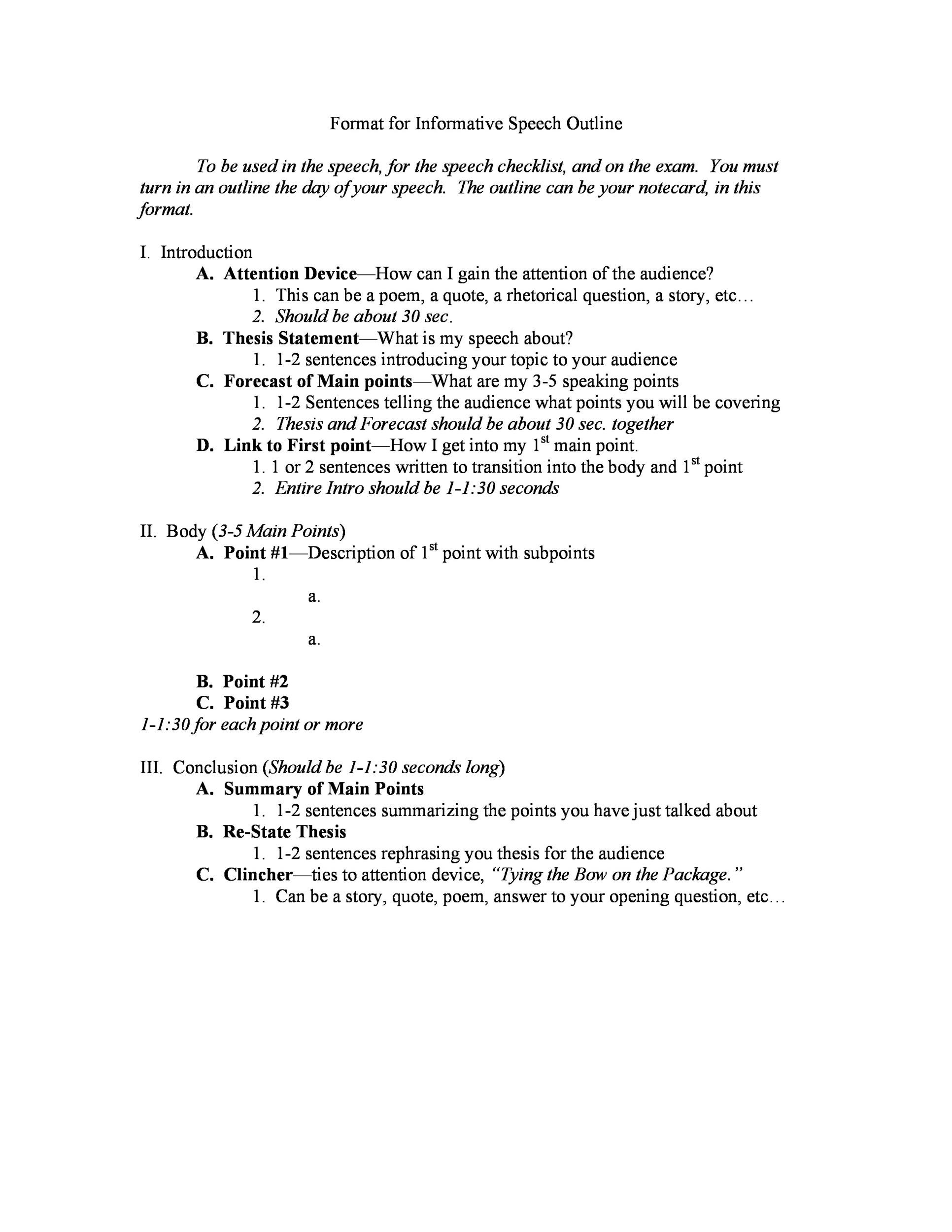
What is an Informative Speech?
An informative speech is a type of speech mostly based on facts and figure. The facts are presented in front of the audience to teach them about a specific topic. It is necessary for an informative speech to have reliable sources to support claims. At times, presenters think to add some life to their speeches by putting in visual aids, images or appealing photographs. This is done to ensure that the audience remains engaged and not get overwhelmed with just facts and figures. As the name implies, an informative speech likely focuses on the general information covering history, evolution and other necessary information in order to teach the audience about a specific topic. For instance, if you are giving an informative speech about baking bread, you can explain the history of bread, its evolution and how to bake it efficiently. Sometimes, people often think that informative essays and informative speeches are one as the same thing, but it is not so. Unlike informative essays , the presentation is the key element for informative speeches.
Furthermore, while giving an informative speech, your tone can vary. You can fluctuate your tone, raising your voice or talking normally. But most importantly, you should include credible sources to support your ideas and claims. The audience can become more knowledgeable on the subject. The speaker of the informative speech should be well-versed about the entire subject and able to answer the detailed questions that are asked. The speaker should do thorough research on the topic and should be able to defend their side.
Normally, there are four types of topics for informative speeches: concepts, objects, events, and processes. Like other types of speeches, an informative speech also has an introduction, body, and conclusion. So, make sure you do include all the parts in order to make the right kind of informative speech outline. If you are not sure about the informative speech outline, you can download the informative speech outline template. We have several different kinds of informative speech outline examples for you. Simply download any of them and edit it with your speech.
Additionally, informative speech is unlike the persuasive speech as it just highlights the facts and figures in order to draw upon conclusions. On the contrary, persuasive speech has certain opinions and conclusions in the speech besides the sourceable facts. An informative speech has limitless options. From fictitious to non-fictitious topics, informative speeches can be given on any kind of topic. But just make sure that you have enough knowledge about it. All in all, the main goal of the informative speech is to provide enlightenment about the specific topic the audience does not know about.
Types of Informative Speeches
Now that you have understood what actually informative speech is, you should also understand that there are different types of speeches. Check out the four types below.
Definitional Speech
In the definitional speeches, the speaker explains the meaning of theories, concepts, issues and philosophies that the audience may not know about. In such types of speeches, the speakers may begin by providing a history of the topic and background to the subject. Let’s continue the similar example which we mentioned above of baking bread.
Considering this example under this form of speech, the speaker would elucidate about what a bread actually is, the history of the bread, how it changed from time and what are the parts of a bread called. The speaker will give shape to such kinds of things throughout the speech.
Descriptive Speech
The purpose of a descriptive speech is to provide vivid and detailed information of a person, place, animal, or thing. Also, it is supported by a word picture. This kind of informative speech is different from the definitional speeches because it helps in determining the characteristics, functions, features and the key points of the topic.
For instance, if you are providing a speech on the famous Statue of Liberty in the United States, you should let the audience know all about its nuts and bolts. You should know what kind of material is used in order to make it, how it was made, what is its historical significance, why is it located on that spot etc. There are many things that you need to answer in these kinds of descriptive speeches.
Explanatory Speech
An explanatory speech is also known as a briefing. Explanatory speech is somehow like descriptive speech as both of them share the function of clarifying the topic. But these kinds of speeches mostly focus on reports of historical and current events, transformations, customs, inventions, outcomes, policies, and options.
Additionally, these speeches focus on the explanations more, considering how and why aspect most importantly. On the contrary, descriptive speeches do not go in too many details while the explanatory speeches go into depth.
Demonstration Speech
Demonstration speech type is also one of the informative speech types that help listeners determine how to accomplish or perform things on their own. This type of speech is based on demonstration. When speakers have to give this type of speech, they focus on the processes having a series of steps which has specific beginning and ending. These types of speeches are normally given to the audience who do not have any know-how about the product. For instance, if a representative is giving speech to the audience in public about a product, they would use demonstration speech approach.
Also, there are certain products that include set of tools and associated features. It can be quite challenging to write the demonstration speeches as they may include several objects, steps, features, related events or relationships. If you want to prepare this speech, you should first remember to keep safety of the audience in your mind. You should make sure that the tools or elements you are using do not hurt the audience.
For instance, if you want to give a demonstration speech using fire, make sure that you do it carefully. There have been many cases in history when demonstration speeches have gone wrong. So, you must ensure to keep the safety of the audience in your mind. Besides, if you want to write a demonstration speech, we have a template available for that too. Simply download it and edit the outline with respect to your needs.
Informative Speech Outline Templates
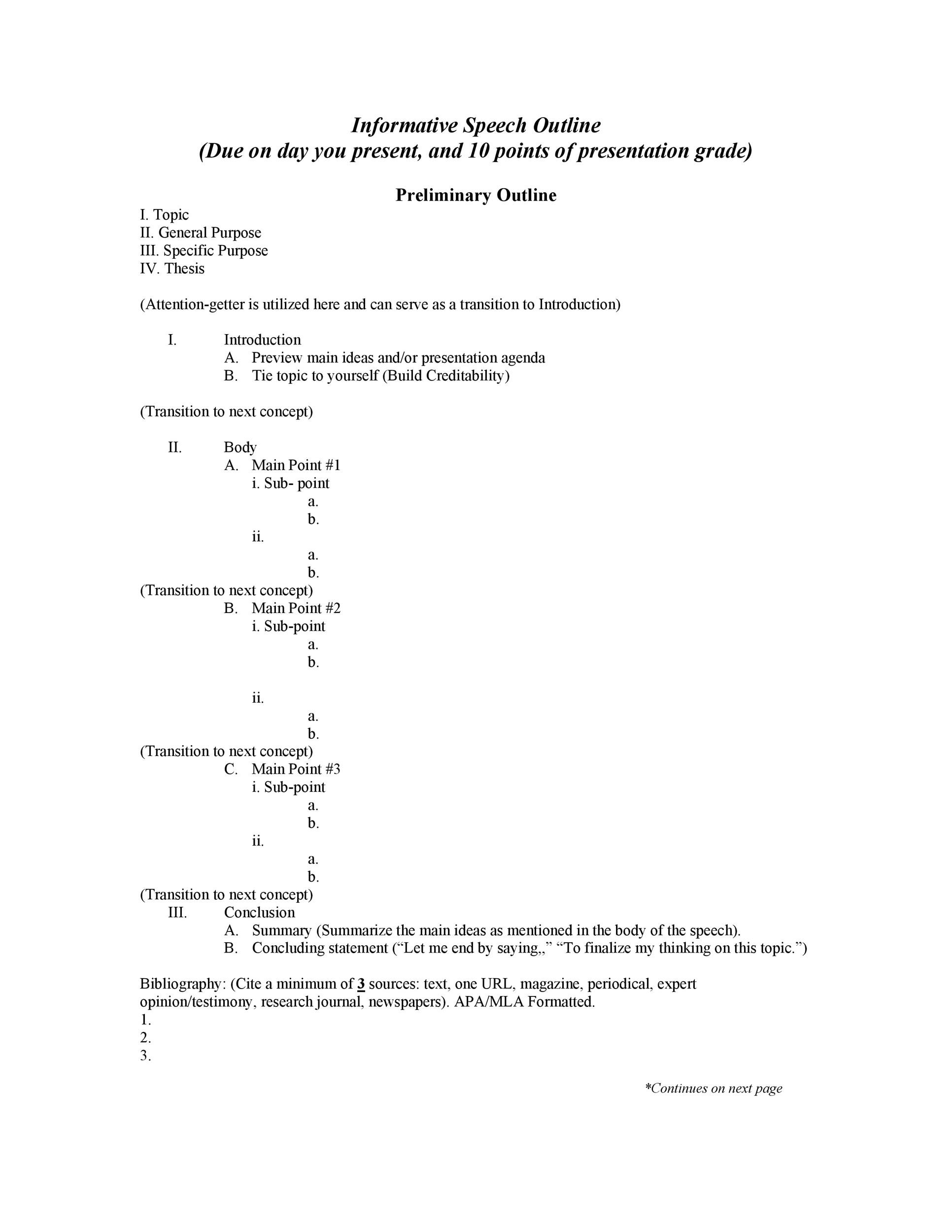
Checklist for Your Informative Speech
According to a research, when you give speech to the audience, words are the least important part while communicating. As per the study, when you do face-to-face conversation with others, you need to focus on your actions. Here are some elements that you need to take care of. Find the checklist for your informative speech below.
Eye Contact
Your audience will get bored if you just read through the text on the presentation. This would not help the audience in understanding the speech you are giving to them. A good speech is the one which is supported by proper eye contact and is accompanied with good presentation skills. Also, according to a study, effective communication is based on trust.
Your audience will trust you if you make an eye contact with them. You should see into the eyes of the audience in order to evaluate if they are interested and grasping the idea or not. The cooperation increases when we watch the audience. When you would make an eye contact, it would increase trustworthiness and also encourage future cooperation.
Tone of Your Voice
In addition to making an eye contact, the tone of your voice is equally important when it comes to giving a speech. Your audience will not be interested if you give the speech in a monotonous tone. Also, informative speeches may also get dull due to the facts and figures in it. Along with the tone of your voice, the facial expressions also matter.
According to experts, if the tome remains the same, neural dissonance takes place inside the brain causing confusion in the person. In order to express joy, your voice should become increasingly melodic and when you want to portray sadness, you can shift your tone to monotonic. There is a lot of variability in both, the speed and tone.
Expressive Hand and Body Gestures
Hand and body gestures also play a very important role. Your audience would get really very bored if you stand straight in one position and do not use your hand and body gestures. The gestures are really very important as they help in the comprehending the language. Audience’s brain would want both, your sound as well as your body movements in order to accurately perceive what is meant.
According to a research, if our gestures and words are dissimilar, it will likely create a confusing state for the listener’s brain. So, you need to ensure that you use your hand and body gestures during your speech but make sure that you do it at the right time. We would suggest you to practice speaking in front of the mirror and use your hands in order to describe the words that you are going to speak in front of the audience.
Informative Speech Samples
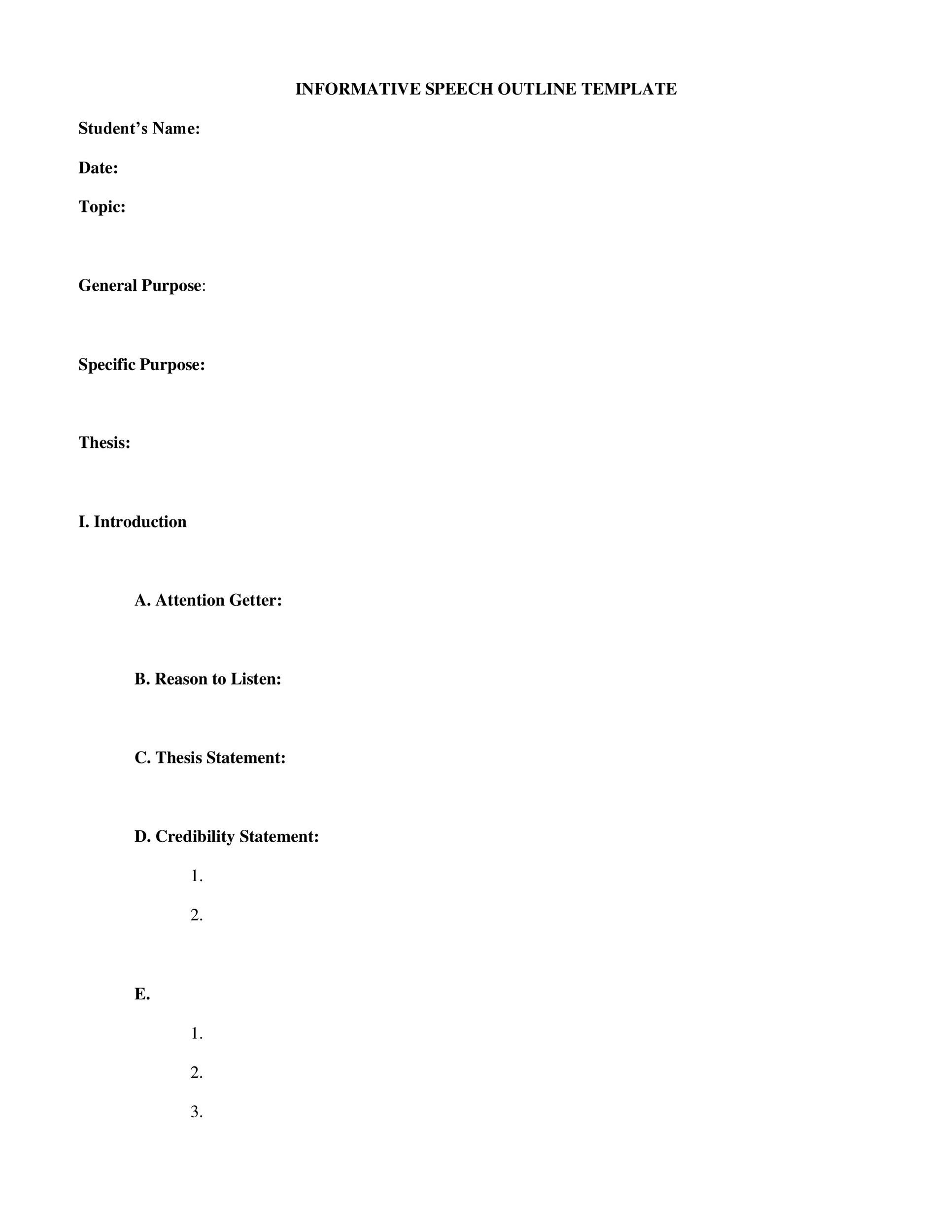
Tips for Your Informative Speech from a Professional
If you want to write an effective informative speech, then you should be following the tips below by the professional.
- You should be providing information in every minute of your speech. There should not be any filler texts or information. An informative speech is made for the core reason to make every minute worth for the audience. Keep in mind that you are not trying to impress them; you are just trying to provide them information during your speech.
- In addition to providing information to the audience, you should also give examples of real world situations so that your audience can relate to the information on practical basis. You are just there to help your audience learn information.
- Make sure that you make an eye contact with your audience in order to help them trust you. Remember that your goal is to educate the audience and make them believe in what you say.
- You should be quite sincere and credible about the speech you are giving to your audience. You should not put the information that you think is not reliable.
- At the end of the information speech, you should be ready to ask questions. Or let your audience know that you would ask them in the end so that they stay prepared by the end of the session.
Informative speech outline is readily available on our main website. If you are looking for informative speech outline template of any type, you can download it from our main website and use for your effective informative speech. We hope our templates help you in giving the best speech.
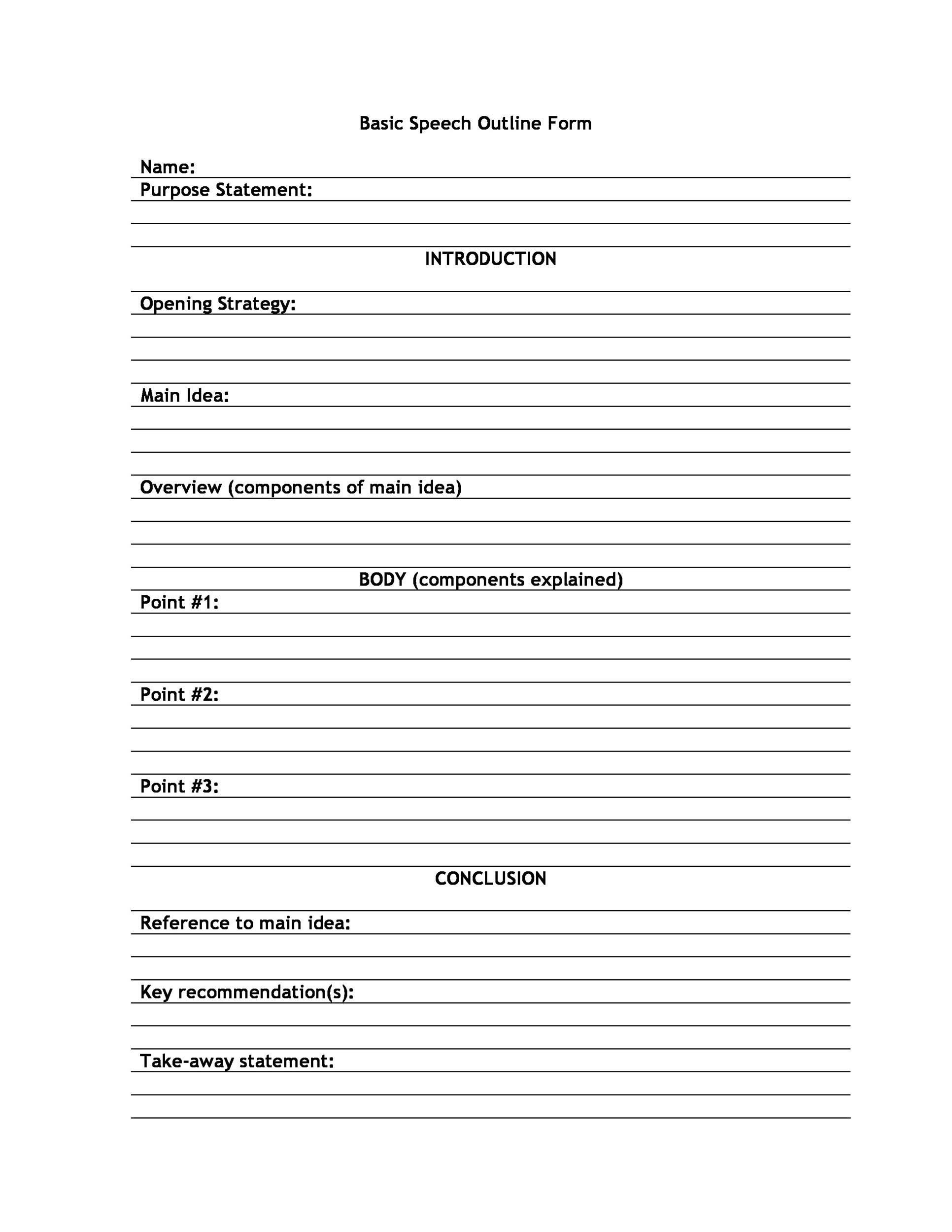
More Templates
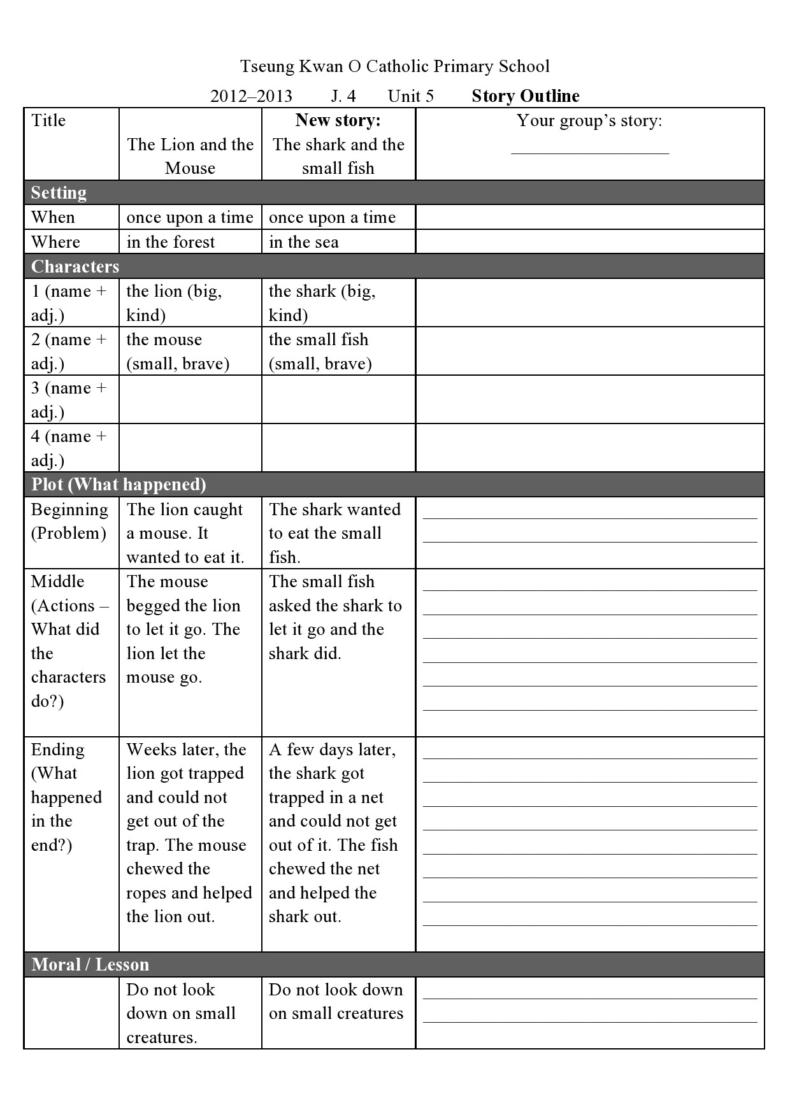
Story Outline Templates
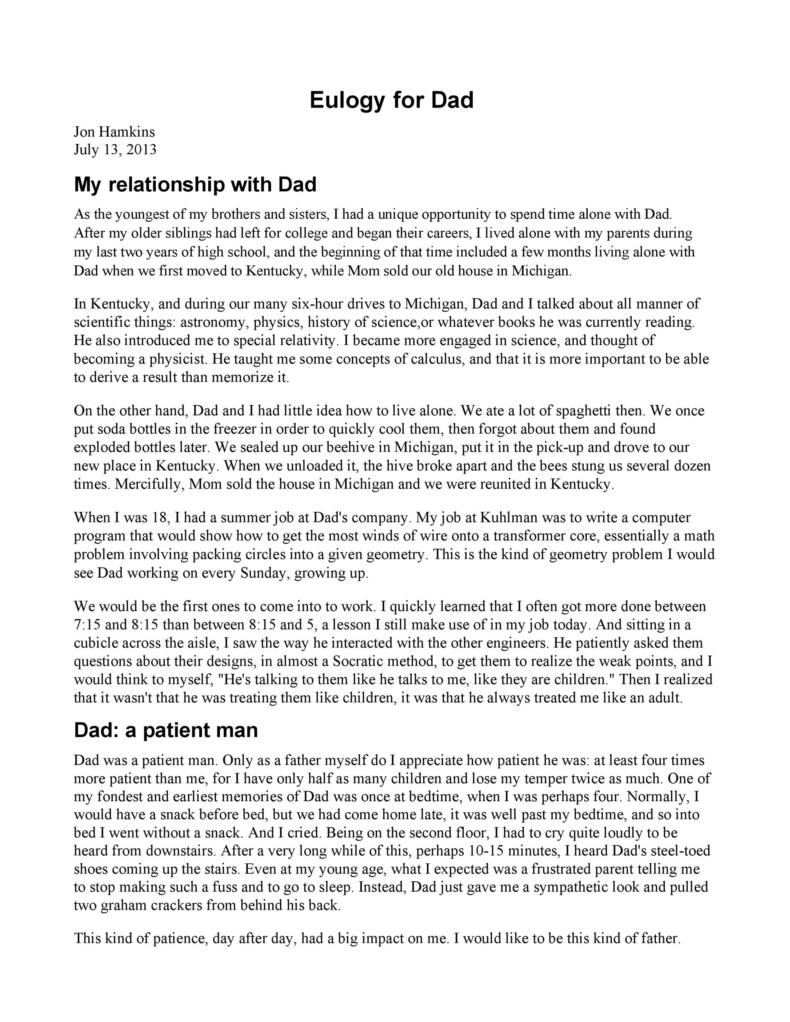
Eulogy Templates
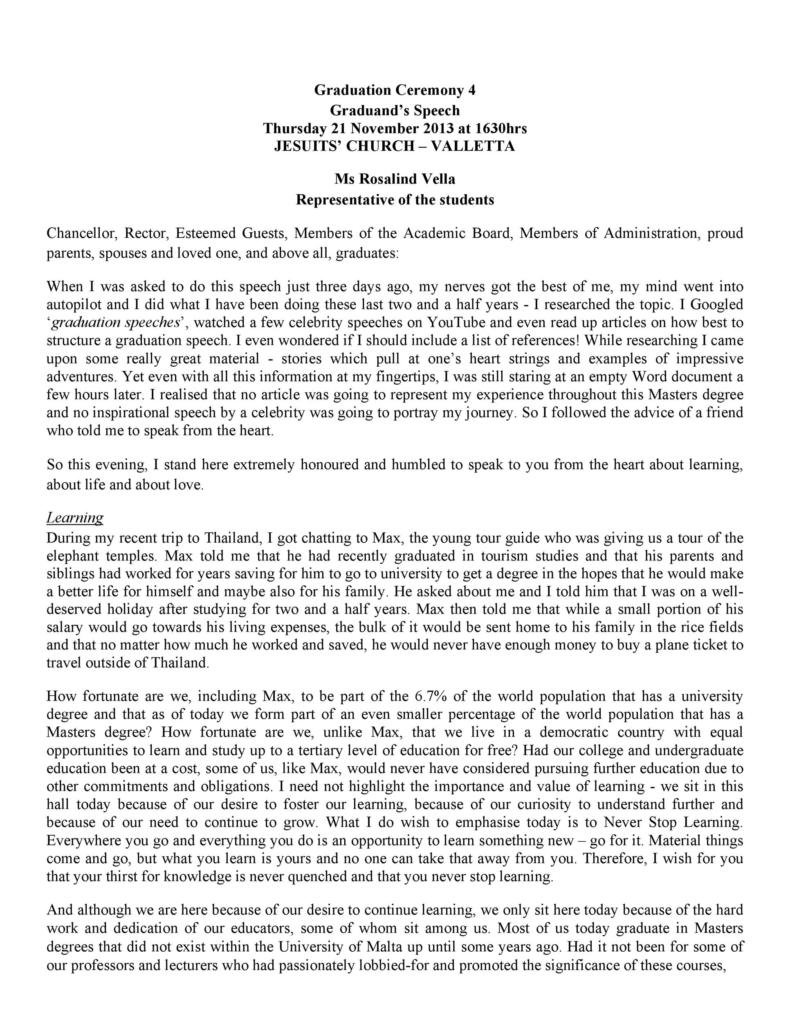
Graduation Speech Examples
Basic Speech Outline
Just like any other piece of writing, you have to make do with an outline to draft your speech. The purpose of this outline is to act as a blueprint for your subsequent presentations. It does this by highlighting the key elements of the speech.
These are basically the points that are expounded on in the speech to support its core message. The introduction, main body, conclusion, key stories, and high-level concepts are top examples of these concepts.

How to Write a Basic Speech Outline
Step 1: open the speech with a greeting and introduction.
As a matter of courtesy, it is a good thing to open the speech with a greeting. Follow this by introducing yourself. Take time also to thank those who have attended that event as well as its organizers. Lastly, thank the person who asked you to arise and speak.
Step 2: establish your credibility
People are always curious to know how qualified you are to speak to them on any issue. That is why you have to establish your credibility. Put differently: who exactly are you and how qualified are you to speak about that issue?
Step 3: preview your major points
To be able to captivate the curiosity of your audience, it is necessary to run them through a preview of the main points you are about to talk about. Doing this will let them hold on their patience for the full stretch. Many people do lose their patience and simply switch off if the speech is too boring.
Step 4: back your arguments with supportive facts
After highlighting the main points, you should now back your arguments with supportive facts and pieces of evidence. These could take the forms of statistics, dates, or quotations from original sources. They go further to vouch for the credibility of the arguments.
Step 5: transition your arguments smoothly
It is important to transition your arguments from one paragraph or point to another. That way, the audience will draw a good connection from one point to another. That will also prevent the disconnects that usually typifies the lengthy speeches.
Step 6: provide a summary of the main points
At the tail end of your speech, you should make a summary of the main points you covered in the speech. This again is to give the listener a second chance to capture the gist of your speech.
Step 7: leave some time for questions
Though not compulsory, it is always in order to leave some time for questions. This is especially if the speech in question was a presentation or a dissertation. Include this in the outline to prevent you from forgetting the same.
Basic Speech Outline Templates

Tips for writing a basic speech outline
- Identify the specific kind of speech. Speeches come in different shades and forms. It is necessary for you to identify the specific kind of speech you are intent on making. This will guide you into following the right channels and including only the critical details.
- State the specific role of your speech. Move next to state the specific roles of your speech. Put differently, what exactly do you hope to achieve with your speech? It is important that you delineate this so as to leave out unnecessary details and dwell on the core roles of your speech only.
- Use a persuasive tone. Speeches are designed to persuade the listeners to take some accompanying yet relevant courses of action. For this feat to be realized, you have to use and maintain a persuasive tone all along. You should not in any way be harsh or use disparaging terms.
- Maintain a uniform pattern of symbolization and indentation. In order for your speech to be read and comprehended smoothly, you have to maintain a uniform pattern of indentation and symbolism. Such a consistent pattern will definitely ensure that there are no glitches or confusion in the course of reading.
- Delineate the internal summaries, transitions, and internal previews. Lastly, you have to delineate the internal summaries, transitions, and internal previews. This again is critical to ensuring that anyone who reads the speech understands it fully and does not get lost along the way.
How did our templates helped you today?
Opps what went wrong, related posts.

24 FREE Story Outline Templates and Examples (Novel, Book, Plot)

Biography Outline Templates & Examples

Outline Template for Essay – Word, PDF

Literature Review Outline Templates (in Word & PDF)

12+ Body Outline Templates

Research Paper Outline Template

Novel Outline Template

Autobiography Outline Template
Thank you for your feedback.

How a Speech Outline Can Help You Persuade Your Audience
Contrary to many politicians, Winston Churchill wrote all of his speeches. From his famous “We shall fight on the beaches” speech addressed to the House of Commons in 1940 to the scores of others, Churchill wrote and delivered his speeches in his own way. Despite his contemporaries describing him as “a word-spinner,” and, “a second-rate rhetorician,” people remember Winston Churchill’s words even today. And in his hand during a persuasive speech, you could almost certainly see a piece of parchment that was his speech outline.
Why Use a Speech Outline?
An organized speech is also more persuasive. A speech where you show your points in a scattershot manner, even if they’re good points, won’t have the same impact as one where you lay out your main points in a logical, convincing fashion. In other words, writing an outline for a persuasive speech will help your comments stay with your audience for longer.
The Two Outline Types
Preparation outline, speaking outline.
The speaking outline is what many people think of when they hear the term “speech outline.” This is the outline you’ll actually have with you when you deliver your speech. The speaking outline shows all the points you want to hit, including any phrases or quotes you’ll want to say word for word. The points serve as helpful guides, allowing you to navigate your way through the speech without needing to look at your papers constantly. This outline acts as a reference point to make sure you provide all the information you want but still sound natural in your delivery. Many people choose to put this outline on notecards that they carry with them as they give their speeches.
Speech Outline Template
Purpose statement, thesis statement, introduction.
The introduction is what will hook your audience. Once you know how to start a speech, you’ll be able to grab people’s attention so you can begin to persuade them. An introduction also establishes a connection with the audience. It indicates why they should listen to you. Openings can also serve as a preview of what you plan on talking about. Getting the speech introduction right is vital because if you lose the audience initially, it becomes challenging to win their attention back.
Bibliography
Transitions.
While preparing your speech, you should also prepare transitions between each of the above sections. Whether moving from the intro to the body or the main point to a sub-point, transitions help smooth out a speech and keep people following along with little effort. Make sure your transitions flow seamlessly from one point to the next. Without them, a speech can come across as jarring and difficult to understand.
Speech Outline Example
Use a speech outline for next time.
Dale Carnegie once said, “There are always three speeches, for every one you actually gave. The one you practiced, the one you gave, and the one you wish you gave.” By creating a speech outline, you’ll show your audience the poise of a practiced public speaker, even if you still get nervous. An outline will help you give an effective speech, one you can be proud you gave no matter what the topic is about.
Want to learn more skills as a leader? The following articles can help:
Top 18 Conflict Resolution Skills Every Leader Needs
WTO / Education / How to Structure Informative Speech | Outline Examples
How to Structure Informative Speech | Outline Examples
Informative speeches are often given on topics that the audience is unfamiliar with, whether it is in a professional, educational, or social setting. This speech is typically prepared following a basic outline to ensure the listeners receive valuable knowledge. Moreover, the outline helps the speaker deliver information effectively and increase audience engagement by structuring it in a logical and organized manner.
This article will introduce readers to such a speech and discuss the basic components of the outline for creating it. It also provides best practices for preparing this speech and examples you can use as a reference to better understand how to structure these.
What is an Informative Speech?
An informative speech is a means of conversing or public speaking where the speaker educates the audience on a particular topic they are not familiar with.
The speaker provides facts, insights, and examples to enlighten the audience. The goal is to educate, not persuade, and therefore, should be free of personal opinions or biases to allow the audience to create their own.
There are four major types:
- Explanatory
- Demonstrative
- Descriptive
- Definition speeches.
To enhance engagement and effectiveness, speakers can utilize visual aids such as slides, diagrams, or videos. Visual aids serve to support and reinforce the spoken content, making it easier for the audience to comprehend and remember the information. It can teach any topic, including scientific findings, social issues, technological innovations, cultural traditions, smoking habits, etc.
Basic Format of Speech Outline
You must organize the content rationally and present it in a manner that is easy to understand. This is achieved by using the correct outline, which is a framework for organizing and presenting information effectively during a speech or presentation.
The basic outline guides you on the points to include and the order in which they should be presented to avoid stress during the preparation stage. This enhances the logical flow of information when delivering the speech. Consequently, this increases the clarity and coherence of your topic.
Below are the fundamental components of such an outline:
The first item on the outline is the title of the topic you will be discussing. The title is meant to introduce the topic by giving them an idea of what will be discussed. It should be short, descriptive, and captivating to grasp the audience’s interest.
“Origin of mental health in the NFL.”
General purpose
Each speech is given with an objective or objectives in mind. The general purpose states the overall objective of the speech, which is typically to educate, inform the audience or raise awareness about a particular topic.
“The long-term negative consequences of contact sports in the country.”
Specific purpose
The specific purpose narrows down to what you intend to achieve through it. You should indicate what the audience should expect to learn by the end of the speech.
“To educate the audience on how concussions affect the health of players in the NFL.”
Thesis statement
A complete outline will include a thesis statement which is an overview of the main message to be delivered. This statement is meant to guide you on the main idea you want to convey to the audience.
“Constant knocks to the head of a player leads to concussions and the lack of policies to compel players to enroll into mental health programs after retiring lowers chances of timely interventions.”
Introduction
The introduction is used to provide a preview of the key points to be discussed in it. It should capture the audience’s attention and provide enough details to generate their curiosity.
The introduction will have the following components:
Attention getter
This is an element used to capture the audience’s attention before you delve into the topic. It can be a quote, question, statistic, poem, or anecdote. The element should be relevant to the topic, engaging, and thought-provoking. However, the quote does not have to be related to the topic. Only use one element at a time.
“Do you know that 3 out of 10 ex-NFL players struggle with mental health issues.”
Topic & audience relevance
Start by explaining why and how the topic is relevant to the audience. To craft a valuable explanation, talk about the significance of the topic to the individuals, specific groups, and society at large. Also, relate the topic to the audience’s interests, experiences, industry, and concerns.
You can discuss and highlight how your speech will benefit or impact the audience. Also, identify common ground with the audience, which can be a shared experience or values to establish a connection that can elicit empathy or understanding.
Establish credibility
Your credibility can impact how well the audience receives your speech. So, your outline should help you prepare how to establish credibility.
Credibility can be established by stating the following:
- Qualifications – This includes relevant education achievements, professional experience, and certifications.
- Expertise – Specify your profession and any relevant projects or research you have undertaken in a related field.
- Personal experience – Share any real-life experiences you have had that would qualify you to discuss the topic in question.
- Research – If you have conducted any research on a particular topic, inform the audience. Also, you can reference people you have consulted in regard to the topic. If they are credible sources, this increases the credibility of your speech.
Preview of main points
The outline prompts you to preview the main points of the topic to be discussed in brief phrases and sentences. This will help the audience understand and anticipate the format in which information will be delivered and the content of your speech. Present the headings logically to help the audience follow along more easily.
The body component in the outline discusses the main content or topic and supporting information. It is meant to prompt you to write down all the main points to be discussed. The content will have the main points, which are then broken down into subpoints. You should consider discussing 3-5 main points, but these can vary depending on the length of your speech.
This section will have the following parts:
Transition sentence to the main point
This is a sentence made to end the introduction and start the body seamlessly. This transition sentence helps the audience follow your speech and maintain a logical flow of information. You should add transition sentences and phrases whenever you want to connect different but related points.
The main point is the core idea, concept, or fact you want to convey to the audience. It should support the thesis and can be given in a single sentence. Also, avoid any ambiguity, as every other piece of information is meant to further expound on this point.
Sub-points are arguments meant to elaborate on the main point. These may include explanations, examples, or research findings. Sub-points will focus on specific aspects, facts, and principles that help clarify the main point. You can have multiple sub-points depending on the depth of information you want to provide.
Sub-sub points
Sub-sub points are used to justify or break down subpoints. These include statistics, examples, stories, and references that provide additional information and reinforce the main point. They should aim at improving the audience’s understanding. Then, for each main point, provide subpoints and sub-subpoints to maintain the logical flow of the speech.
This component of the outline is meant to guide you to end the speech on a positive note. It summarizes the information shared with the audience.
Reiterate the key point(s) by incorporating the following elements in your conclusion:
Transition sentence to conclusion
The transition sentence from the last main point to the conclusion indicates to the audience that you are about to finalize your speech. Use transition words, phrases, and sentences to connect everything discussed in the entire speech.
Summary of main points
Briefly summarize the key message you wanted to educate the audience about. Also, state any key takeaways the audience should keep in their mind.
Restate your thesis
Restate the thesis in the introduction using different words but retaining the argument. Also, connect the message to your purpose. Reiteration of key elements etches the main idea or concept in the audience’s minds.
Closing statement
At the end, provide a closing argument that is memorable and impactful. Aim to leave a lasting and positive impression on the audience in one of the following ways:
- Call to action – A call to action directs the audience to take specific actions related to the topic discussed in the speech. For instance, participate in a program, change their behavior, support a cause, etc.
- Thought-provoking question – You can end by raising a question that jogs the audience’s mind and prompts them to learn more about a topic.
- Powerful quote – Use a quote that is relevant to the message to strengthen the main points further and leave the audience thinking.
- Hopeful message – Also, you can end with an inspiring message to motivate and inspire the audience in different aspects of their lives, such as being kind, working for their goals, patience, etc. Ending on a positive note can encourage the audience to retain the information you conveyed.
When you follow this simple outline during the preparation stage, your key message will be delivered effectively, and the sitting will prove productive for you and the audience. However, note that you can modify this basic format to ensure your speech aligns with the time constraints and the topic in question.

Free Templates
Given below are outline templates that you can download for free:
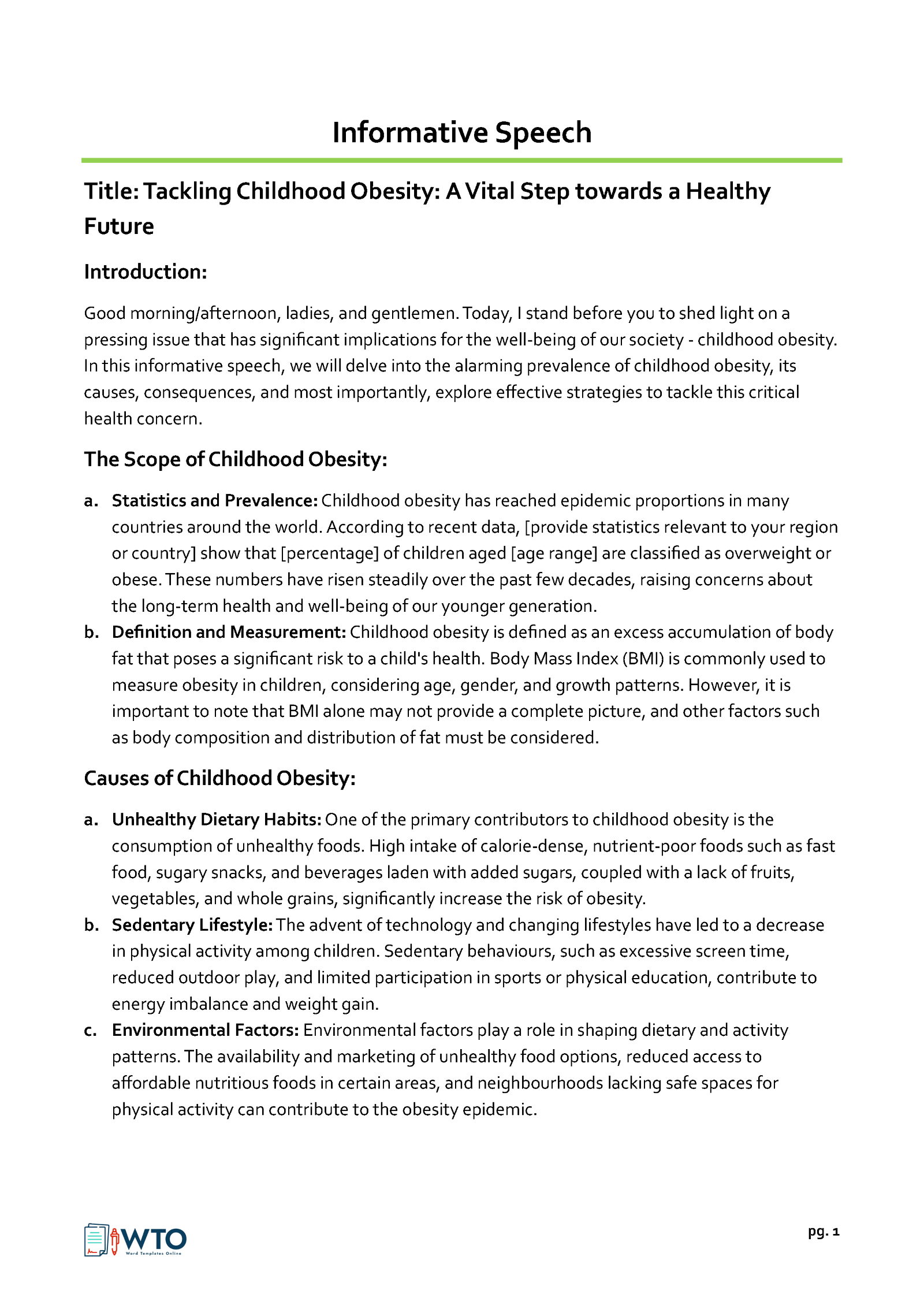
4 Best Practices to Consider for Writing an Outline
Your outline should help you capture all the relevant details and organize them in a comprehensive and palatable message. So you can tailor it to the specific speech you are preparing.
Below are things you can do to develop a more effective outline:
Research thoroughly
Research your topic extensively and gather accurate, reliable, and up-to-date information. Then, you can craft an outline that captures and conveys this information effectively.
Consult examples
Review multiple examples to get an idea of the basic format of well-structured speeches. Identify how to introduce a topic, convey the key message and conclude the speech. Then, craft your outline and incorporate any unique elements and strategies that will be effective depending on the topic, audience, and forum.
Use visual aids
You can use charts, images, slides, and props to explain your points. Visual aids increase audience engagement and understanding. They can also be useful to explain complex concepts and leave lasting impressions.
Engage the audience
Encourage the audience to actively participate during the sitting by asking questions, holding polls, or doing short activities that break the monotony and keep their minds engaged. This can make it more memorable and help the audience understand the key message better.
Informative speeches are effective tools for educating an audience on a topic you are well-versed with. However, to ensure you convey your message effectively, it is advisable to use a simple outline to prepare how to speak to the audience. While there are basic outline templates you can download, you should personalize them to suit your topic and style of giving speeches. Also, it is advisable to consult several samples to understand how to organize your points.
About This Article

Was this helpful?
Great! Tell us more about your experience
Not up to par help us fix it, keep reading.

Charts , Education
22 free printable homework planners (templates).

12 Free Yes No Flowchart Templates (PowerPoint)

Education , Guides
How to write an essay outline (21 examples – templates).

35 Printable Homeschool Schedule Templates [Free]
Thank you for your feedback.
Your Voice, Our Progress. Your feedback matters a lot to us.

How to Write and Deliver a Compelling Narrative Speech (With Examples)
- The Speaker Lab
- August 8, 2024
Table of Contents
If you want to elevate your public speaking game, storytelling is one of the best ways to do so. By weaving captivating tales into your presentations, you’ll forge a powerful emotional bond with your audience in a way you can’t with mere data and statistics. Not sure where to begin? Look no further than these narrative speech examples , designed to spark your creativity and help you craft your own compelling narratives.
From personal anecdotes to historical tales, these examples will demonstrate the power of storytelling to engage, persuade, and inspire. You’ll also see how great speakers use vivid language, descriptive details, and relatable characters to draw their listeners in and keep them hanging on every word. So get ready to take notes, because you’re about to unleash your inner storyteller!
What Is a Narrative Speech?
If you’ve ever been captivated by a great story, then you know the power of storytelling. A narrative speech is a type of speech that uses a personal story or narrative to engage the audience and illustrate a point. It’s one of the most effective ways to connect with your listeners on an emotional level.
Elements of a Good Narrative Speech
So, what makes a good narrative speech? First and foremost, it needs to have a clear beginning, middle, and end. Your story should have a strong opening that hooks the audience, a compelling middle that builds tension and keeps them engaged, and a satisfying conclusion that ties everything together.
If you want your story to pack a punch, don’t skimp on the specifics. Describe what you experienced using the five senses: sight, hearing, smell, touch, and taste. When you paint a vivid picture with your words, your audience will feel like they’re right there with you, experiencing every thrilling moment firsthand.
Benefits of Giving a Narrative Speech
But why bother with a narrative speech in the first place? Because stories have the power to change hearts and minds. They allow you to connect with your audience on a personal level, making your message more memorable and impactful. Think about it—when was the last time a list of facts and figures moved you to tears or inspired you to take action? Probably never. But a well-told story? That can stay with you for a lifetime.
Find Out Exactly How Much You Could Make As a Paid Speaker
Use The Official Speaker Fee Calculator to tell you what you should charge for your first (or next) speaking gig — virtual or in-person!
How to Choose a Topic for Your Narrative Speech
Now that you’ve unlocked the potential of narrative speeches, the next step is selecting the perfect topic. Look for a narrative that not only resonates with you on a personal level but will also strike a chord with your audience.
Brainstorming Ideas
Start by brainstorming speech topics that are meaningful to you. Think about pivotal moments in your life, lessons you’ve learned, or challenges you’ve overcome. Consider stories that highlight your values, passions, or unique experiences.
One brainstorming technique is to make a list of “firsts”—first love, first job, first big failure, etc. These moments often make for compelling stories because they’re relatable and emotionally charged.
Narrowing Down Your Options
Once you have a list of potential topics, it’s time to narrow them down. Ask yourself which stories are most relevant to your audience and the message you want to convey. Which ones have the most dramatic arc or the most valuable lessons?
You also want to consider your comfort level with each story. Some stories may be too personal or emotionally raw to share in a public setting. Others may not have enough substance to sustain a full speech. Trust your gut and choose the story that feels right for you.
Ensuring Your Topic Is Engaging
Finally, make sure your chosen topic is engaging and compelling. A good story should have some sort of conflict or tension that keeps the audience on the edge of their seats. It should also have a clear theme or message that resonates with listeners.
To determine if your story is a crowd-pleaser, put it to the test by sharing it with your inner circle. As you weave your narrative, watch closely for signs of engagement or boredom. Then, afterwards, ask for feedback on how you can improve your narrative speech—and don’t be afraid to ask for examples of how you might re-write specific sections. Jot down these suggestions and use them to fine-tune your story, ensuring it’s a hit with any audience.
Crafting an Outline for Your Narrative Speech
Now that you’ve nailed down your topic, it’s time to roll up your sleeves and craft a speech outline . Trust us, having a clear roadmap will make all the difference when it comes to delivering your message with confidence and clarity.
Introduction
Begin your speech with a hook, something that will pique your audience’s interest and encourage them to keep listening. Oftentimes, speakers like to use a shocking statistic or a captivating anecdote to kick things off.
For example, if your narrative speech is about overcoming a fear of public speaking , you might start with something like, “Imagine standing in front of a room full of people, your heart racing, your palms sweating, your mind going blank. That was me, just a few years ago.”
The body of your speech is where you’ll tell your actual story. Break it down into clear, chronological segments with smooth transitions between each part. Use vivid details and sensory language to bring the story to life.
As you’re writing, consider incorporating dialogue, humor , or suspense to keep the audience engaged. You might also use rhetorical devices like repetition or metaphor to drive home your key points.
As you wrap up your story, consider the bigger picture. What insights did this journey reveal to you? How have you grown as a person because of it? Think about the key takeaway you want to leave with your readers—something that will stick with them long after they’ve walked away.
End with a call-to-action or a thought-provoking question that encourages the audience to reflect on your message. You might also circle back to the opening anecdote or question to create a sense of closure.
Incorporating Characterization Techniques
To make your story more engaging, consider incorporating characterization techniques. This means giving your characters distinct personalities, motivations, and quirks that make them feel like real people.
Firstly, bring your characters to life through their conversations. The words they choose, their facial expressions, and even their body language can speak volumes about who they are and what makes them tick.
Secondly, to help your audience visualize your characters, use rich descriptions of their physical attributes, fashion choices, and distinct behaviors. Paint a picture of what they look like, how they present themselves through their attire, and any idiosyncrasies that define who they are. By bringing your characters to life, you’ll make your story more relatable and memorable for the audience.
In order to create a narrative speech that truly stands out , you’ll need to put in the time and effort to refine your craft. The reward? An opportunity to share a personal story that not only entertains but also motivates and inspires your audience, forging a connection that lasts long after the final word is spoken.
Delivering Your Narrative Speech Effectively
Before we get to narrative speech examples, let’s take a look at speech delivery. Speech delivery isn’t just about the words you say, but how you say them. Your body language, eye contact, and vocal delivery all play crucial roles in engaging your audience and making your story memorable.
In addition, practice until you can recite your story in your sleep. When you know your content like the back of your hand, you can focus on engaging with your listeners and making your words come alive.
Practicing Your Speech
Rehearsing your speech is of utmost importance. It’s a step that many speakers overlook, but it can make a world of difference in your delivery. When you practice, you familiarize yourself with the flow of your story, allowing you to speak more naturally and confidently.
One technique you find particularly helpful is recording yourself delivering the speech. When you watch the playback, you can identify areas where you need to improve your vocal variety, adjust your speaking rate , or refine your body language. It’s a powerful tool for self-critique and growth as a speaker.
Engaging Your Audience
When you take the stage, your focus should be squarely on those who have gathered to hear you. Eye contact is just the beginning; truly engaging your audience means creating a genuine connection and making them feel like they’re right there with you, experiencing your story firsthand. Try using words like “we” and “us” to make your audience feel included. Asking questions can also get them thinking about what you’re saying.
Using Props and Visual Aids
Your narrative speech may revolve around your words, but don’t underestimate the impact of a carefully selected prop or visual aid. These tools can make abstract ideas tangible, evoke strong emotional responses, and ensure your message lingers long after you’ve left the stage.
However, it’s important to use these tools judiciously. Overreliance on props or visuals can distract from your message and undermine your credibility as a speaker. When selecting props or creating visual aids, always ask yourself: does this add value to my story, or is it just a gimmick?
Overcoming Nervousness
Even seasoned speakers get the jitters sometimes. Before stepping up to the mic, take a moment to ground yourself with some breathing exercises. Visualize yourself delivering your story with confidence and poise, and watch as that nervous energy transforms into pure charisma on stage.
Remember, your listeners are your biggest supporters. They’ve gathered to hear your unique perspective and leave feeling uplifted. Rely on the effort you’ve put in, breathe deeply, and allow your fervor for your message to radiate throughout the room.
Examples of Compelling Narrative Speeches
Great speakers have always known the secret to capturing an audience’s attention: storytelling. Whether it’s an ancient Greek orator spinning a yarn or a modern-day TED Talker sharing a personal journey, the ability to craft a compelling narrative is what sets the best speakers apart. So, what do these narrative speeches look like in action? Let’s dive into some narrative speech examples that have educated, inspired, and motivated people across the ages.
Inspirational Stories
Inspirational stories are those that uplift and motivate us to be our best selves. They often involve overcoming adversity, achieving a seemingly impossible goal, or making a positive difference in the world. Take, for example, Amy Purdy’s narrative speech about the power of imagination. In case you aren’t familiar with the name, Amy Purdy is a Paralympic snowboarder who lost both her legs below the knee due to bacterial meningitis. In her TED talk, she shares her journey of resilience and adaptation, showing how she turned a devastating setback into an opportunity to inspire others.
Humorous Anecdotes
Want to instantly connect with your audience? Try sprinkling in some humor. A well-timed joke or absurd anecdote can break the ice and leave your listeners in stitches. Keep them on their toes with unexpected twists, and they’ll be hanging on your every word.
Darren LaCroix, a professional speaker, frequently uses humorous stories in his talks. Take a look at how he uses his stories of failure in this speech to motivate his crowd to chase their dreams.
Emotional Tales
Emotional tales have a way of grabbing our hearts and not letting go. These stories frequently revolve around individual challenges, the pain of loss, or powerful moments of clarity that reshape a person’s path forward.
One example of an emotional narrative speech is Steve Jobs’ 2005 Stanford Commencement Address , in which he shares three personal stories that shaped his philosophy on life and work. From his adoption story to his battle with cancer, Jobs’ tales are raw, honest, and deeply moving.
Motivational Narratives
Ever heard a story that made you want to jump up and take on the world? That’s the power of a motivational narrative. These inspiring tales feature everyday people doing incredible things—conquering challenges, chasing their passions, and proving that with hard work and determination, anything is possible.
If you want to hear an inspiring tale, check out J.K. Rowling’s Harvard Commencement Speech . She shares her personal journey of failure and resilience, and how she used her imagination to create one of the most adored book series ever. It’s a beautiful story about the power of storytelling and never giving up on your dreams.
Want to hook your audience, tug at their heartstrings, and spur them to action? Take a look at some narrative speech examples from those who’ve mastered the craft. But as you do, don’t forget: your story, told in your unique voice, is the most powerful tool you have. Share it boldly, and watch as it transforms lives.
Ready to Get Your First (Or Next) Paid Speaking Gig?
Download our free 26-page guide and get the 14 exact steps you can follow to book a paid speaking gig right now!
FAQs on Narrative Speech Examples
How do you start a narrative speech.
Kick off with a hook that grabs attention. Maybe share an unexpected fact, ask a thought-provoking question, or launch into the heart of your tale.
What is an example of storytelling?
An example would be recounting how overcoming acute anxiety before a big job interview taught resilience and self-confidence.
Dive straight into setting the scene or introduce your main character in action. Let listeners feel they’re right there with you from the get-go.
What are examples of narrative speech?
Narrative speeches might explore personal growth through volunteering experiences or share humorous anecdotes about learning to drive. They weave personal stories to engage and enlighten audiences.
Storytelling is a timeless art that has the power to captivate, inspire, and transform. By studying these narrative speech examples, you’ve seen firsthand how weaving narratives into your presentations can create an emotional connection with your audience and make your message unforgettable.
In order to engage your audience, focus on your characters. Additionally, include details that engage the senses. And don’t be afraid to get a little personal. After all, your own experiences can be the most powerful stories of all.
With these tips in mind, go forth and tell your stories with passion, authenticity, and purpose. Your audience is waiting to be inspired by the narratives only you can tell. Happy storytelling!
- Last Updated: August 6, 2024

Explore Related Resources
Learn How You Could Get Your First (Or Next) Paid Speaking Gig In 90 Days or Less
We receive thousands of applications every day, but we only work with the top 5% of speakers .
Book a call with our team to get started — you’ll learn why the vast majority of our students get a paid speaking gig within 90 days of finishing our program .
If you’re ready to control your schedule, grow your income, and make an impact in the world – it’s time to take the first step. Book a FREE consulting call and let’s get you Booked and Paid to Speak ® .
About The Speaker Lab
We teach speakers how to consistently get booked and paid to speak. Since 2015, we’ve helped thousands of speakers find clarity, confidence, and a clear path to make an impact.
Get Started
Let's connect.
Copyright ©2023 The Speaker Lab. All rights reserved.
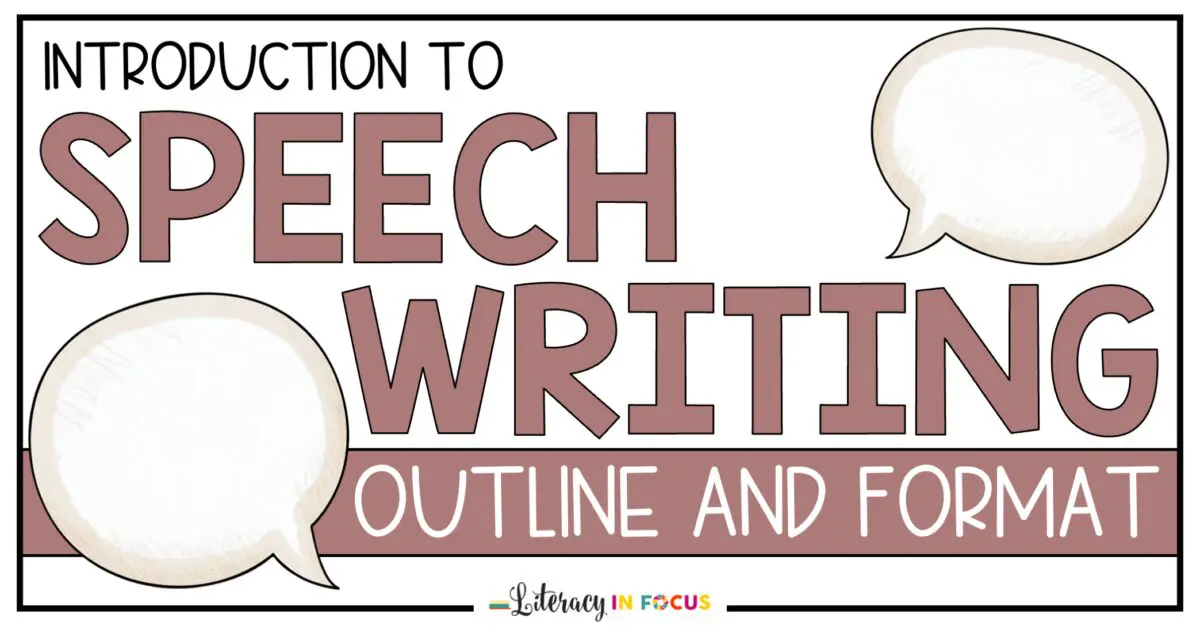
Speech Writing Outline and Format for Students
Learning how to write a speech is a skill most students will need help refining. Guide your students through the speech writing process with the outline and descriptions below. All of the major components of a speech are included and explained in a format students can understand and apply. Once students understand the step-by-step method for crafting a successful speech, they will feel more confident speaking in front of an audience.
I. Introduction
The beginning of a speech is called the introduction. The introduction is important because it sets the tone for the entire presentation. The introduction can be broken into two parts: the attention grabber and the preview.
A. Attention Grabber: Capturing the attention of the audience is the first thing the speaker says or does. In order to do this, the speaker might tell a humorous story, ask a rhetorical question, describe a hypothetical situation, or share an interesting fact.
B. Preview: The second part of the introduction is when the speaker introduces himself or herself and the topic of the speech. The main points of the speech can also be presented at this time.
II. Body
After the introduction, the speaker transitions to the body of the speech. This is where the speaker will spend the most amount of time. The goal of the body of the speech is to clearly explain the topic.
A. Main Points: To clearly explain the topic, the body of the speech is broken down into main points. The number of main points will vary from speech to speech. Regardless of the number, it is important to keep the main points organized in a purposeful way. Also, clear transitions between main points (and throughout the speech) are critical. Without them, the audience will have trouble following along.
1. Supporting Details: Each main point needs supporting material to help the audience understand and remember that point. Examples, explanations, visual aids, and props can be used as supporting material.
III. Conclusion
The conclusion puts the finishing touches on the speech. It lets the audience know that the speech is about to end. Like the introduction, the conclusion can be broken into two parts: the review and the final statement.
A. Review: During the first part of the conclusion, the speaker restates the topic of the speech and each main point.
B. Final Statement: The speech ends with a strong final statement. The final statement addresses the topic one last time in a powerful and meaningful way. The purpose of the final statement is to round out the speech and provide the audience with a strong signal that the presentation is complete.
Click here to download everything you need to teach your students how to write an organized speech. The comprehensive lesson includes “How to Write a Speech” informational text, comprehension questions, example speech, speech outline template, speech writing rubric, and a list of 40 student-friendly speech topics.
Speech Writing Lesson Bundle
“This was an excellent way to begin the year in my speech class. It was very informative for students, had a fun appearance, and was easy to follow. I know I will use this every semester! Thank you!” -Kim O.
Students LOVE this microphone!
This wireless Bluetooth microphone is perfect for student presentations, read alouds, speeches, and so much more! The microphone has 27 colorful LED lights that flicker in rhythm with the voice. You can also use this wireless microphone as a portable Bluetooth speaker. It’s available in a bunch of different colors, and it comes with a nice storage case.
⭐️⭐️⭐️⭐️⭐️ Over 18,000 ratings on Amazon!
“The kids loved this! I think it encouraged them to try to talk more!”
This post contains affiliate links. Click here to read my affiliate policy .
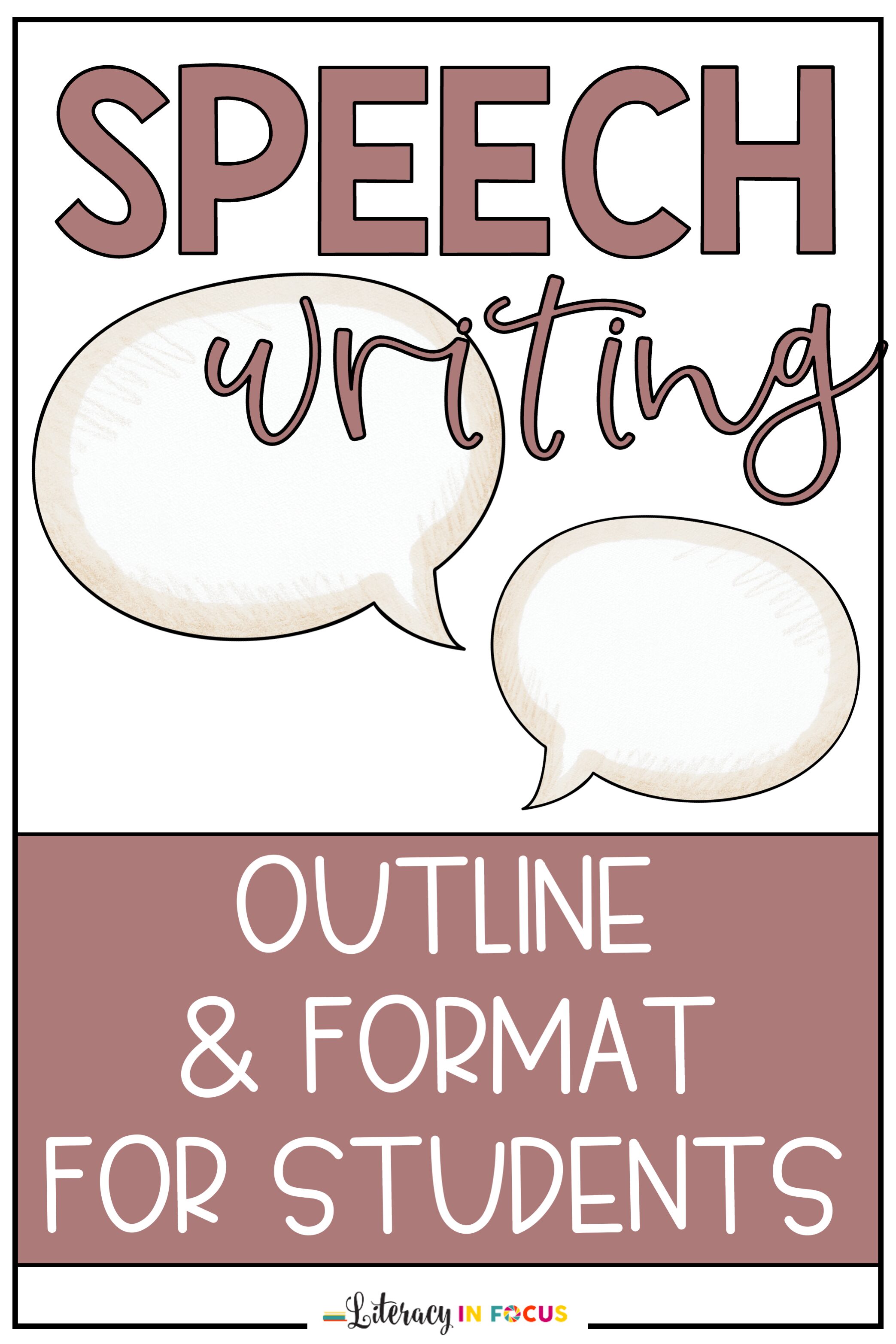

Speech Generator
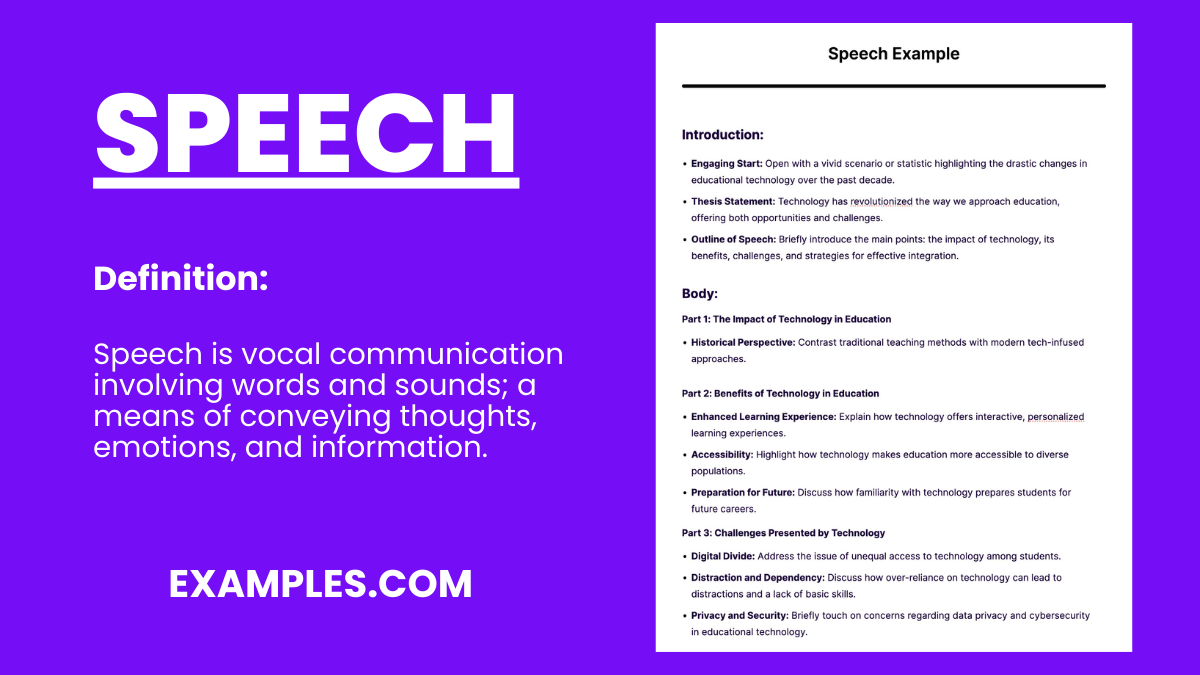
Writing a welcome speech can be a tricky task. There are multiple bases that need to be covered and you have to make sure you don’t lose track of the main point. With a constant flow of ideas, it’s natural for one to get sidetracked so easily. It’s important for you to organize your thoughts properly.
- Republic Day Speech Examples
To deliver the perfect speech is a whole other challenge. You need to develop a set of speech skills for your speech template to receive its desired impact. It can be nerve-racking to speak in front of an audience. It requires constant practice and constructive criticism to become better.
What is Speech Definition & Meaning Speech refers to the expression of thoughts and feelings through spoken language. It is the act of talking and communicating verbally with others, using words to convey ideas, information, or emotions. Speech can range from everyday conversation to formal presentations and public speaking. It’s a primary way humans interact and share information with one another.
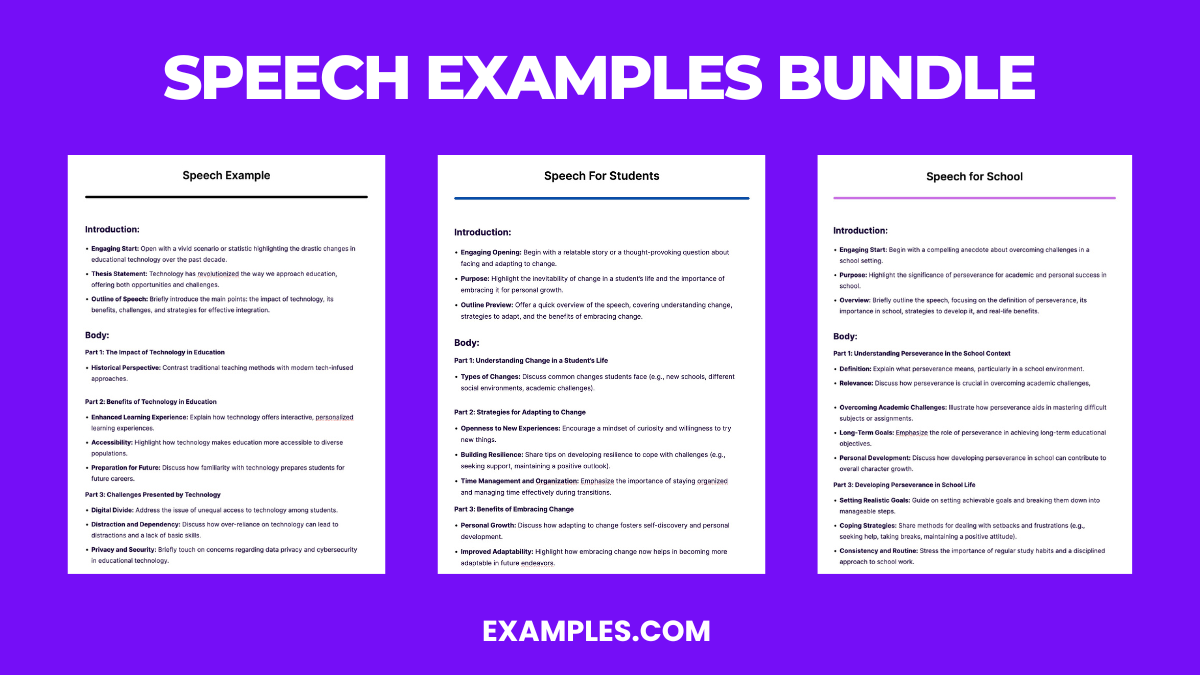
Download Speech Example Bundle
Speech template has been part of our life since we were young. It is the first thing that we learn and taught to us. It is our main form of communication and without it, we could not achieve diplomacy. Without speech, there will be no world peace. Yes, speech has been known to create peace in our time. Remember Martin Luther King? His speech “I Have A Dream” that inspires millions of people. That alone is leadership speech that convinces people to stand up and fight for what is right. A speech no matter, how short can have a huge impact on the one listening.
Speech Example

Download in PDF
Speech For Students
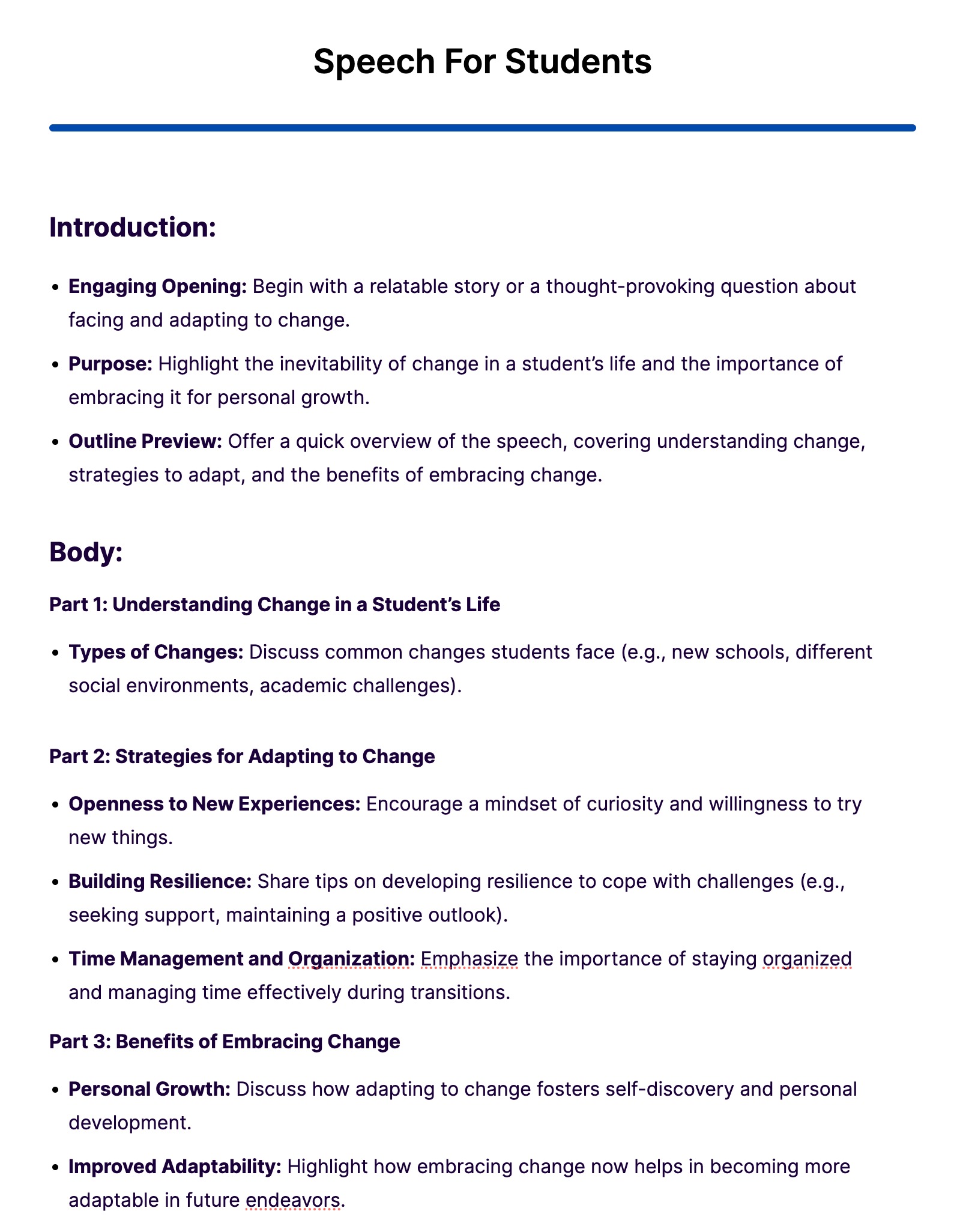
Speech for School
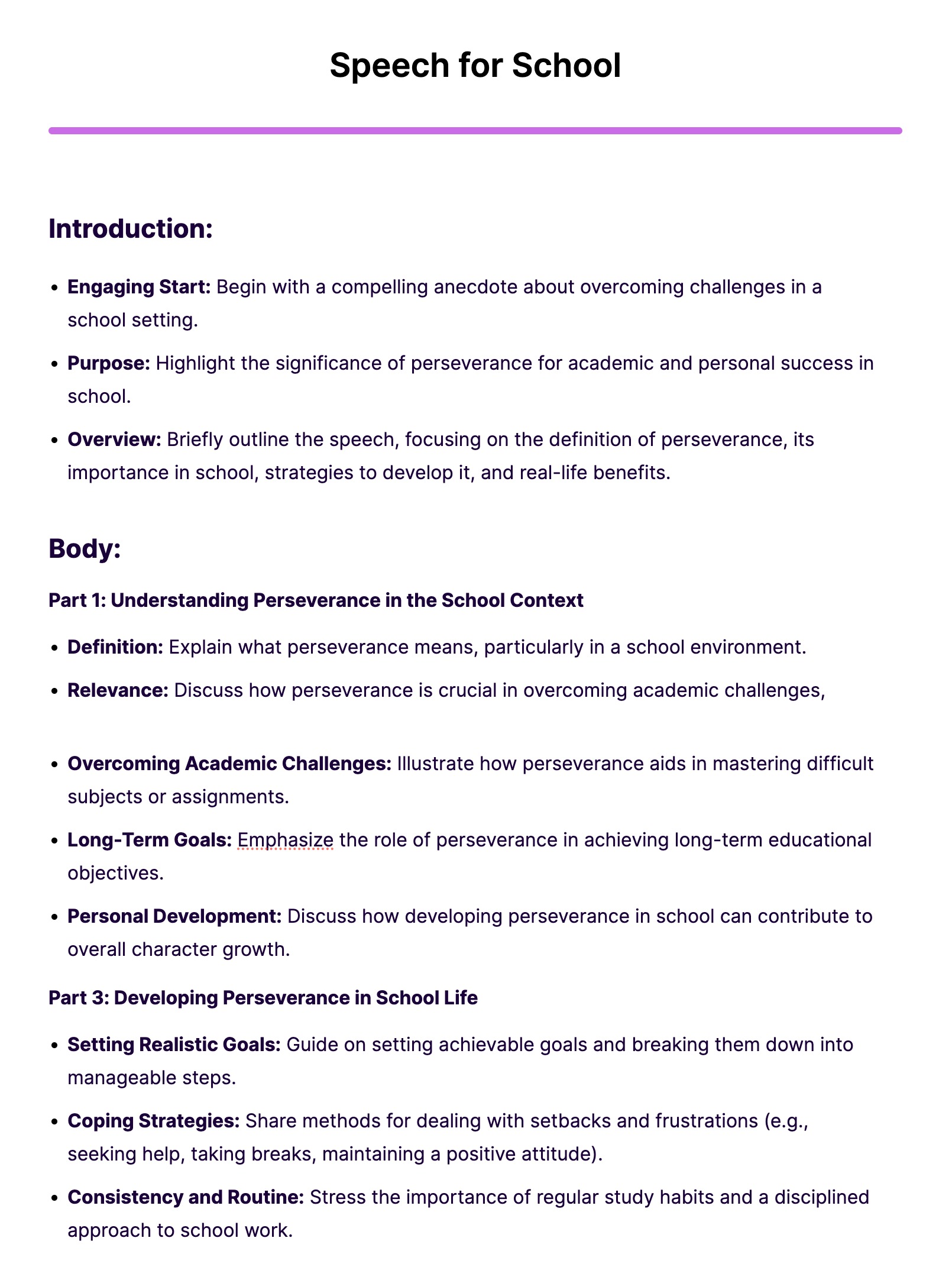
Free Download
College Farewell
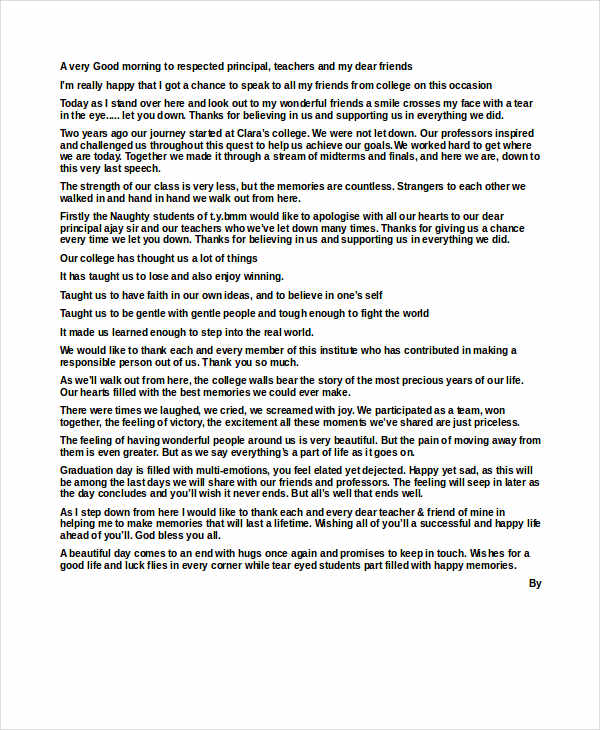
sharminshaikh.blogspot.in
Sample Farewell Speech
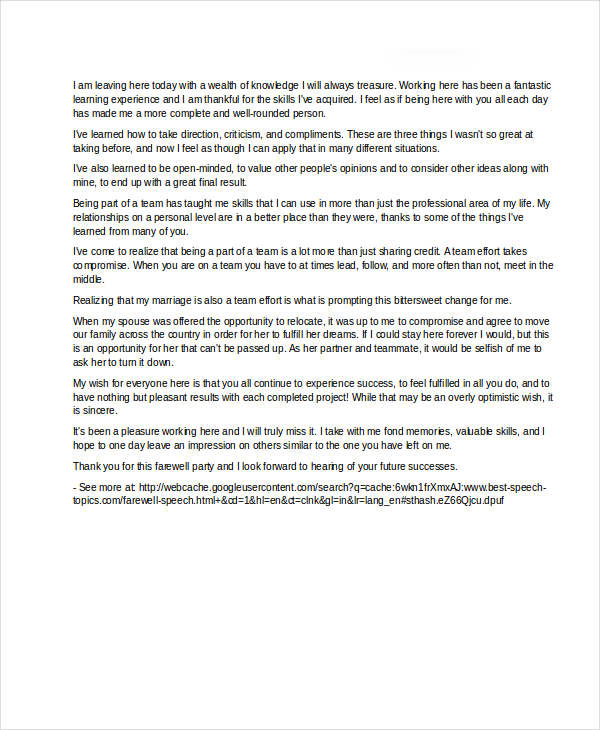
best-speech-topics.com
Informative Speech Outline
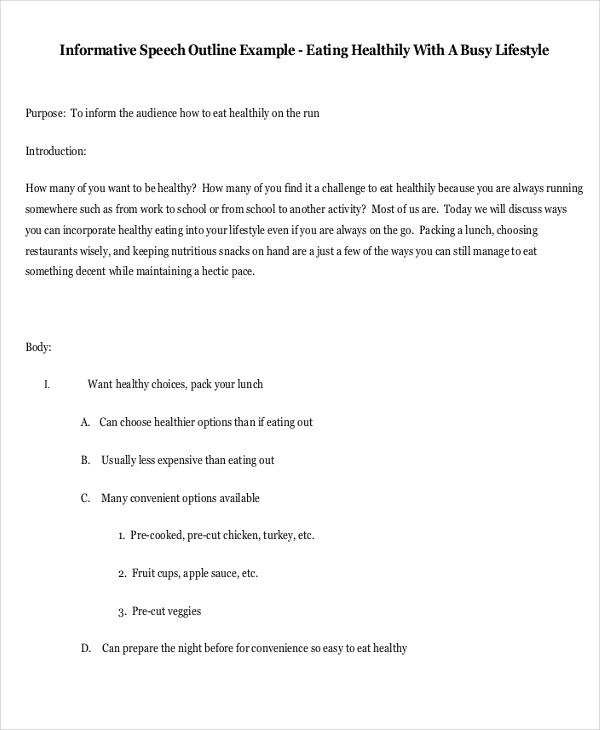
earlham.edu
Size: 44 KB
Expository Speech Outline
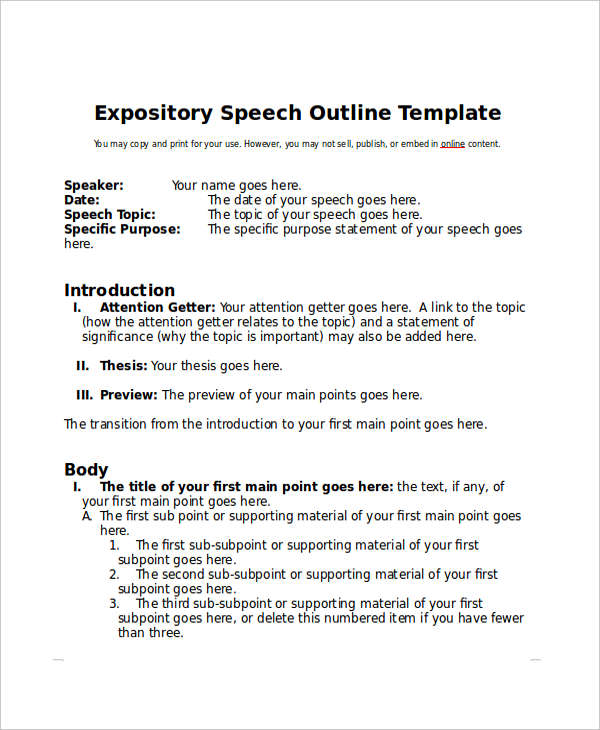
eschool2.bsd7.org
Size: 17 KB
Graduation Speech Example
Student graduation speech.
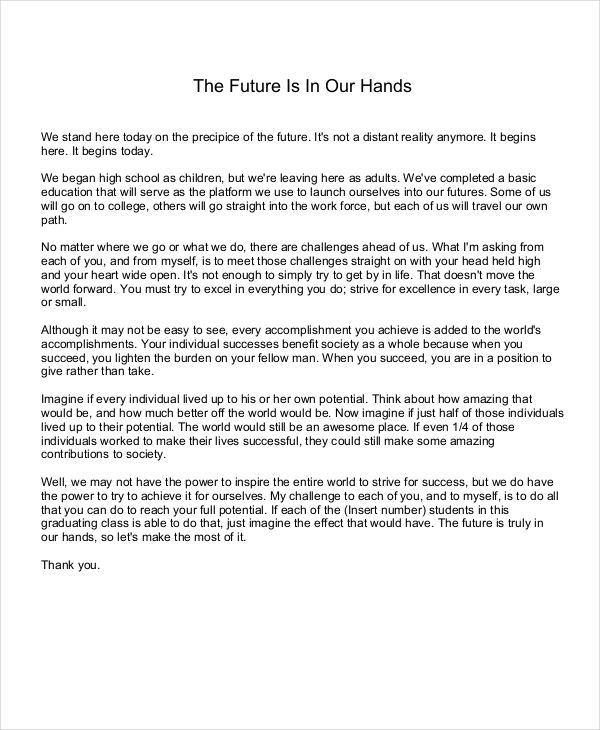
cf.ltkcdn.net
Size: 500 kB
Nursing School Graduation Speech

Size: 22 kB
University Graduation Speech
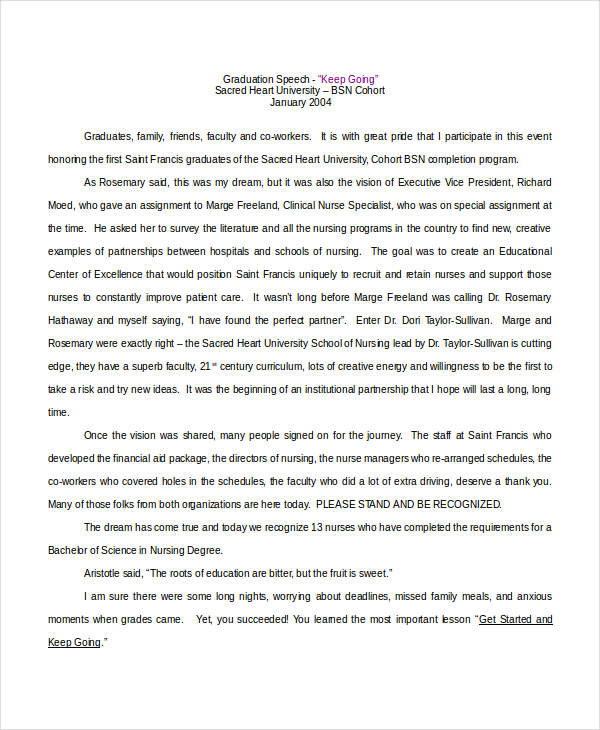
saintfranciscare.com
Graduation Welcome Speech

digitalcommons.law.yale.edu
Size: 71 kB
Graduation Party Speech
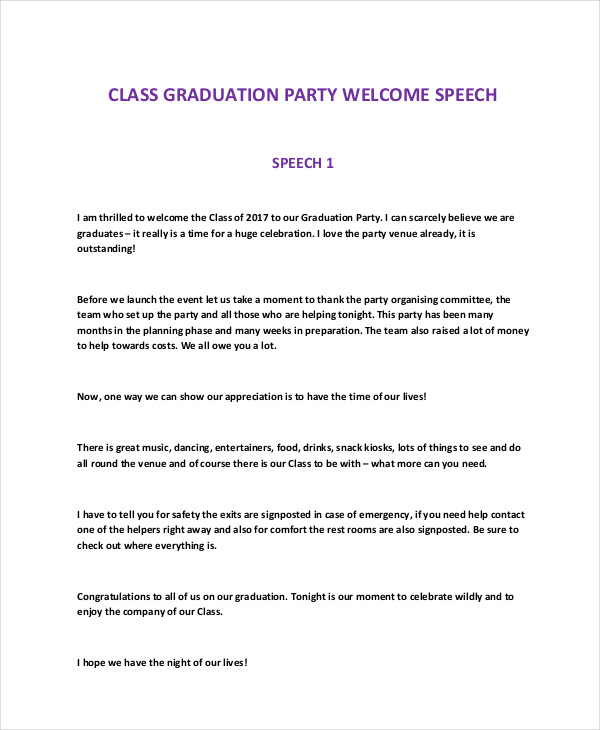
graduation-invitations-graduation-party.com
Size: 139 kB
High School Graduation
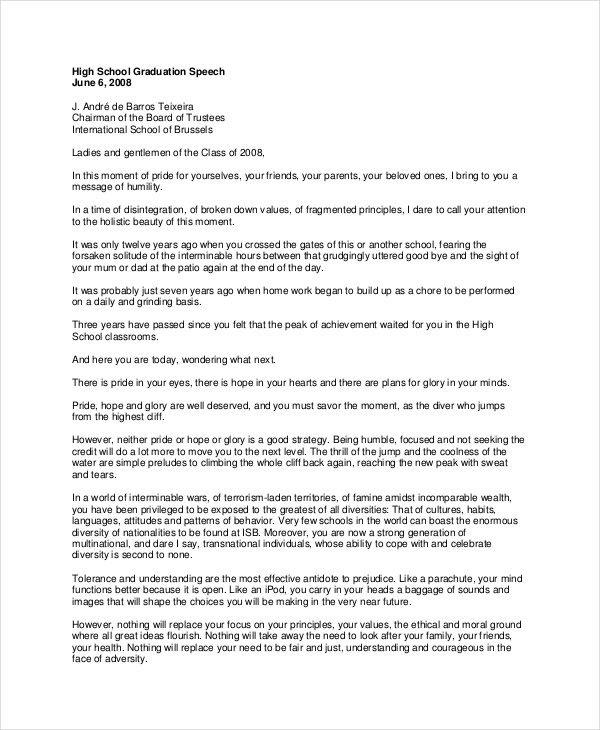
What Is a Speech?
A start a speech, as defined by most website dictionary is a communication or expression of thoughts in spoken words. But most expert orators and speech writer define speech as a formal address given to a large number of people that the purpose of is to persuade, inform, convince, and seek to inspire the people.
However, speech these days, are used to inform people about something or someone. To give them knowledge and information about something that has not been known or is hidden from them. A informative speech is also used to express an emotion and to make a strong stand about one’s belief.
How to Outline a Speech
Speech outline can be a great tool for you to manage your speech and how you will deliver it. Especially if you have trouble in creating and delivering a speech. Here are the steps on creating a speech outline. Basically, a speech outline has 4 essential steps:
Preparation
- This is the part where you decide your topic and your main subjects.
- Determine your audience.
- Identify your purpose.
Introduction
- Create a compelling and attention-getter introduction speech .
- State your main subjects and main points.
- An overview of your whole speech
- Use a transition statement to connect your body to the introduction.
- Discuss your main subject.
- Use supporting details.
- The summary of your speech
- Strong closing statement.
Speech Outline
Persuasive speech.

japanetwork.org
Informative Outline
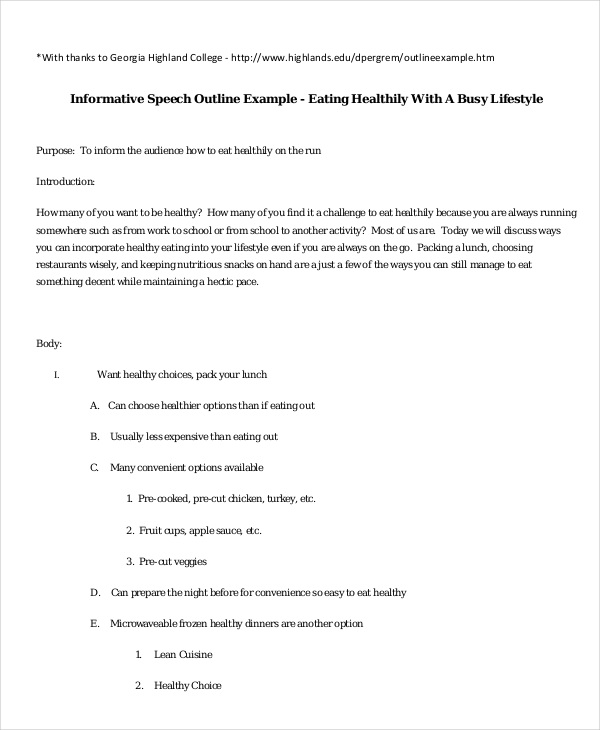
Size: 44 kB
Components of Speech
Effective verbal communication of your ideas and thoughts to others is the general aim for speech classes. Before that, let us take a closer look at the components of writing a speech:
From the moment we first draw breath and announce our arrival into the world, our voice comes into play, a unique amalgamation of our vocal folds and breath to produce sound. This essential aspect of communication, varying distinctly from person to person, is shaped by a myriad of factors including our physiological makeup. It’s particularly pivotal in presentation speech , where the voice becomes more than just a tool for sound; it’s a medium for conveying ideas, emotions, and intentions. In the realm of public speaking or presentation, the voice serves as a powerful instrument, capable of influencing, persuading, and engaging audiences, transforming the mere act of speaking into an art form that resonates and leaves a lasting impact.
2. Articulation
Another component for speech which is equally important is our ability to articulate or control our voice. Meaning how we make the sound of something. Proper articulation also effective leadership speech or oral communications.
Fluency in speech, akin to rhythm in music, is a skill honed through practice. It encompasses the ability to modulate speaking pace, balancing speed with necessary pauses and breaks. This aspect of verbal communication is crucial in special occasion speeches , where the flow and tempo of words significantly impact the effectiveness of the message conveyed. Mastery of fluency transforms speeches into captivating performances, engaging audiences and delivering messages with clarity and impact.
Tips for Giving a Speech
To deliver a powerful and meaningful speech, take note of our hand-picked tips on giving a welcome speech. This is specially made for both newbie and veteran when it comes to giving a speech to the audience.
- Prepare ahead of time . This is important for you to reduce your anxiety and the nerve-wracking feeling.
- Determine your topic . Before giving a speech, you must know and master your topic and the material that comes with it. It is best if you pick a topic that you are interested in or you have a massive background about it.
- Know your audience . When it comes to giving speeches, the best thing to do is to have a little background check of who will be your potential audiences. That way you will know if you could use some s elf-introduction speech .
- Have a quick tour of the room or place where you will give your speech . So that, when the time comes you can maximize your placement on the stage and you will know where to go and face the audience.
- Think like a performer . With the above said that you have to maximize the stage, you also have to walk around, speak to the audience, and use hands gesture to signify your strong emotion about your speech.
- Practice makes (almost) perfect . The keynote speech to every successful speech is practice. Rehearse your speech over and over again to find any mistakes and awkward moments. It is also best to practice your speech in front of your friends or family to give you the feeling of what it is to be in the real situation.
- Be confident . You have to believe in yourself that you can give a successful speech so that the audience will also believe in that too.
Follow those tips and you are good to go. Also, if you want to know more about how you can give an amazing speech, you can browse our speech templates and examples here.
What Is a Speech Template For?
A speech template serves as a guide to simplify speech writing. It does not contain the word-for-word details of the speech outline its basic parts. Common speech examples contain these three essential parts:
- Introduction – It often starts with a quote, a question, or a story.
- Body – This is where the topic’s main points are thoroughly discussed. A written copy of the speech should present important phrases only.
- Conclusion – A summary of what was presented is given. A remark or a call to action serves as thestatement of conclude speech .
How to Start a Speech
To start a speech , you must know the purpose of the speech you are making.
Is it a speech for special occasions? Should it be serious or can it be playful? A special occasion speech has the power to set a mood in a room. For instance, a graduation speech must be encouraging and inspiring. It must be able to garner attention from an audience.
Once you are able to determine the purpose of the speech, it would be easier for you to organize your words into the main parts of the speech.
How to Give a Professional Persuasive Speech

fountainheadpress.com
Size: 84 kB
3 Minute Speech Example

academichelp.net
Tribute Speech Example
Tribute on retirement.
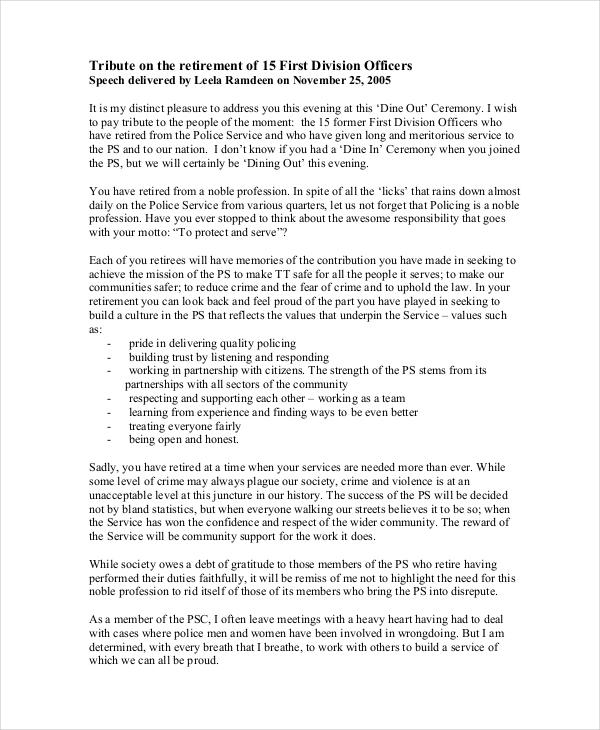
rcsocialjusticett.org
Size: 75 kB
Parent Tribute Speech
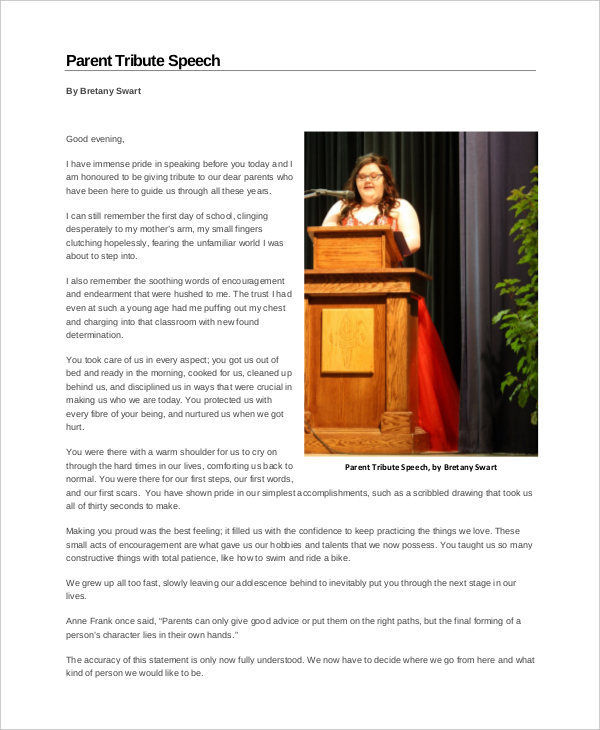
foxinfocus.ca
Size: 260 kB
Types of Speech
Speeches are divided into three types: Informative, persuasive, and impromptu.
- Informative speech. This speech focuses on giving the audience complete (or partial) information about people, events, things, and life. Informative speeches are often used in curricular activities.
- Persuasive speeches. Persuasive speech talks about facts, opinions, the point of views about issues or controversies. The speech must tailor the message to the audience for it to become effective.
- Impromptu speech . This speech is done with little or without preparation. A high speech skill is required when giving this speech.
You can check out our examples speeches here to give you more ideas about the three types of speeches. You can use it in your graduation speech or in your thank-you speech .
Importance of a Good Speech
There are numbers of reason why a good speech is important. There’s a lot actually. I could only name 3 on top of my head.
- It can gain positive perception and opinion from the audience . A good speech does not only make the audience “wow,” it can also give you significant feedbacks from them that you can use in your future development.
- It can express fully your emotion and feelings . You can express what you really want the audience to feel about your speech.
- It can provide complete information . Having said that, a good speech will also make the audience understand and comprehend of the topics you have discussed.
Retirement Speech
Teacher retirement speech.
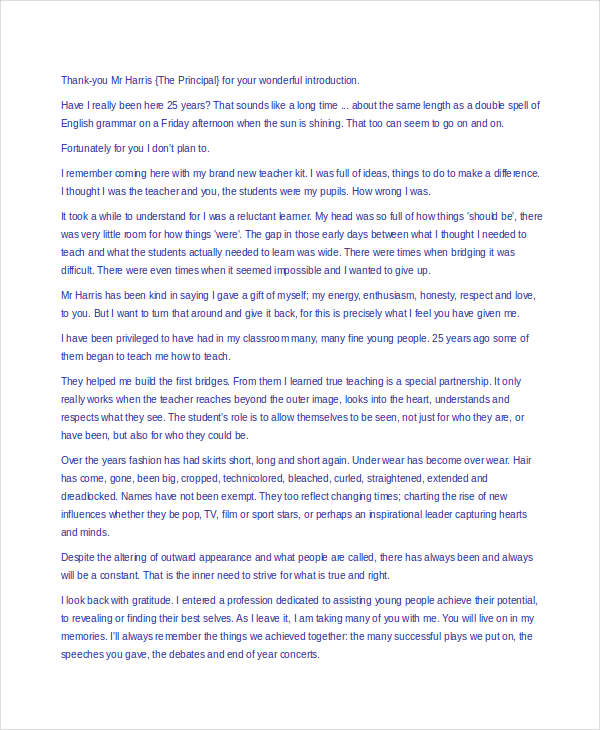
write-out-loud.com
For the Retirement of Administrative Assistant
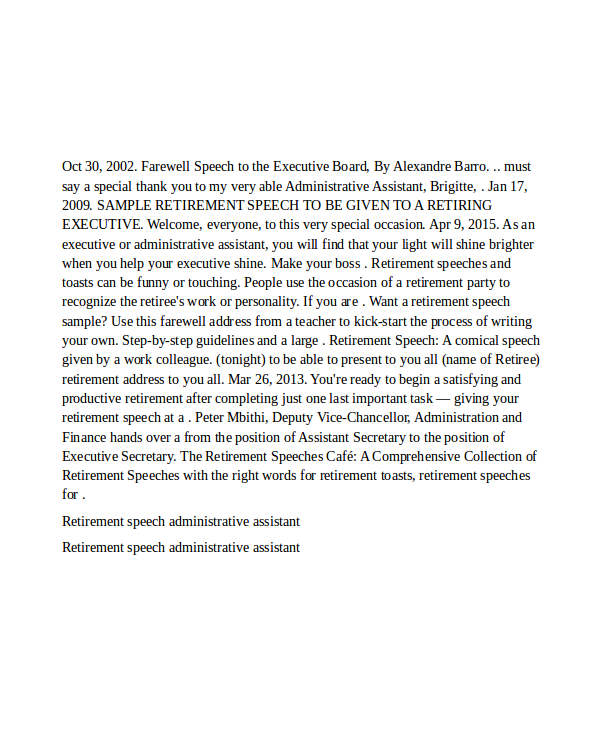
uz.kfty.gdn
Farewell Speech Example
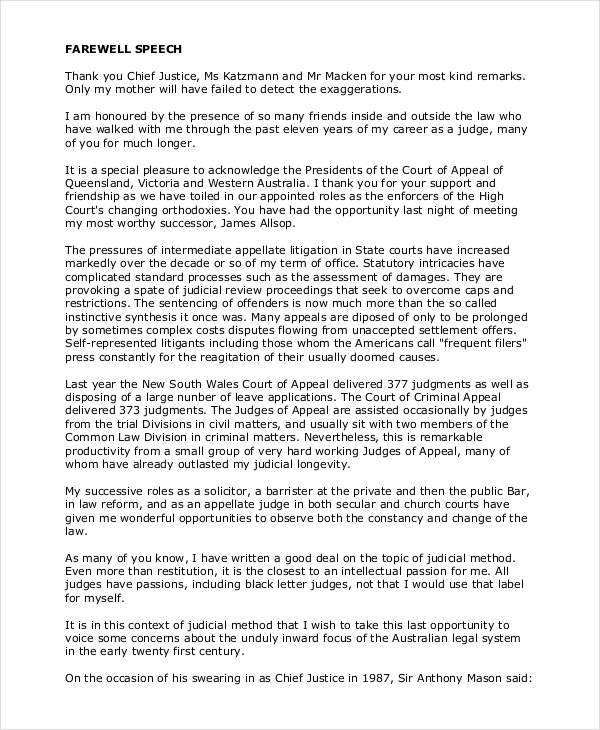
Size: 43 kB
Salutatorian Speech Example
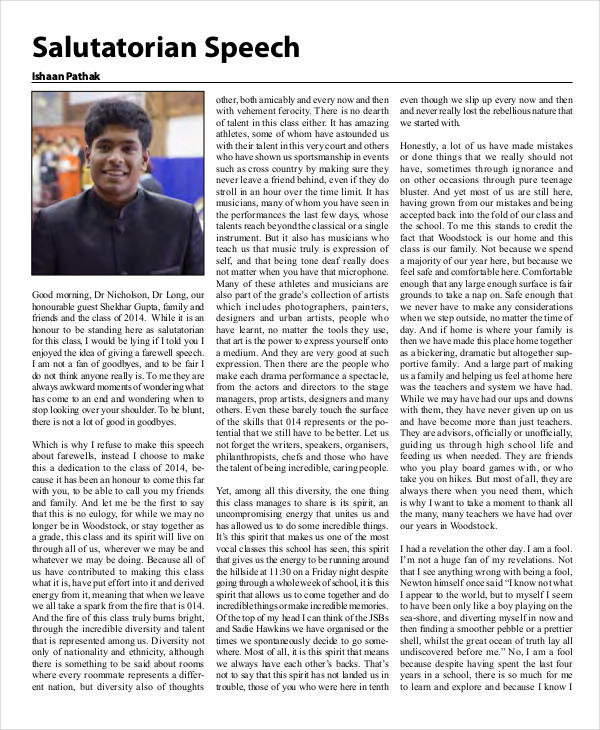
woodstockschool.in
Size: 171 kB
Guidelines for Creating a Speech Outline
As a speaker, you are given the floor to discuss a particular topic over a span of time. Regardless of the type of audience you may face, it’s always best to come prepared. One way is by constructing a speech template as your guide. Here are some guidelines you can take note of when making your s peech template:
- State the purpose of your speech. Whether you wish to inform, to persuade, or to pay tribute to something, determining your purpose will make it easier for you to approach a topic.
- Set a time frame. It’s easy to get carried away while speaking in front of a crowd. Allocating a time limit for the main parts of your speech is a good way to stay on sample schedule .
- Identify the main idea. The main idea will serve as a basis for your thoughts. This will guide you in crafting the main points and the sub points of your speech.
- Include an attention-getter. This is usually found at the start of your speech. It could be a compelling question or a witty story, anything that is sure to grab everyone’s attention from the very start.
- Keep it structured. An effective way is by using roman numerals instead of bullet points. It presents a step by step guide for important details to remember and include in your speech.
- Avoid sequencing your main points in a random order. This is to avoid confusion especially when presenting conflicting statements.
- Observe proper transitions. Transitioning statements and ideas can be challenging. You must be able to gradually transition one point to another.
- Present supporting evidences. If necessary, it’s good to state facts and their sources especially when delivering an informative speech. This is to establish credibility in your speech.
Examples of Introduction Speech
Self introduction sample.
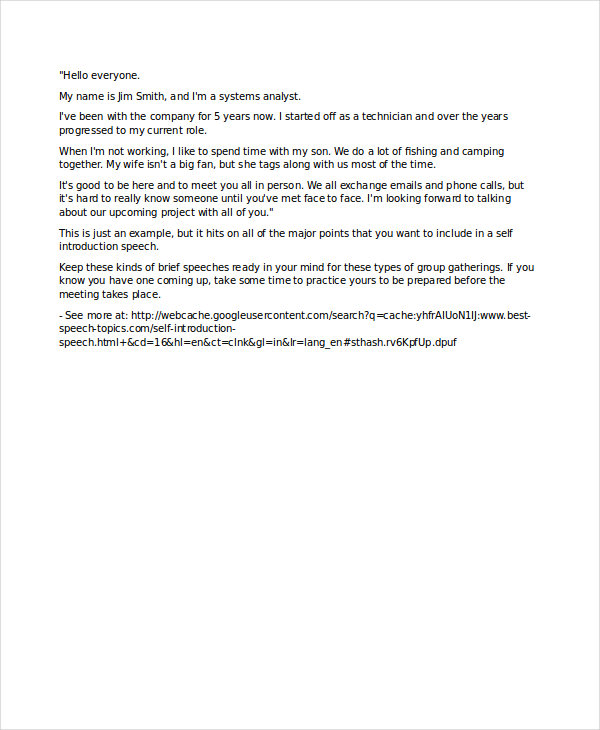
Informative Speech Concept Example
Informative speech for a group.
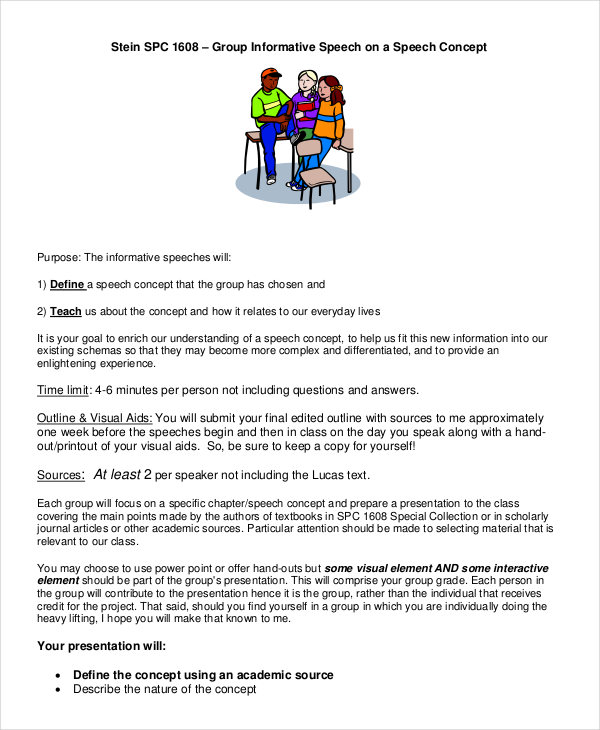
Size: 100 kB
Welcome Speech Example
Wedding welcome.

Formal Welcome Speech

Size: 57 kB
Public Speech Example
Awareness speech.

presentationmagazine.com
Purpose of a Speech Template
To deliver a good speech, it’s important to come prepared. For instance, you were asked to prepare a presentation speech about your boss. You don’t know a lot about him, so you need to conduct your research on that matter. Of course, it can also be intimidating to present a significant individual in front of a large audience. A speech template will allow you to keep important notes and details on hand. It also creates structure for your speech and it ensures that your ideas flow smoothly.
Importance of a Speech Template
A motivational speech requires a lot of time and effort to make. A lot of people would prefer to just wing it instead of taking the time to create one. But the truth is, a speech template will save you time when delivering your speech and it will help avoid any problems caused by inadequate preparation.
A speech template will allow you to sequence information effectively. There’s nothing worse than experiencing dead air while delivering your speech just because you blacked out on what you were supposed to say. You can find various keynote speech examples that can serve as your guide for creating your template.
Motivational Speech Example
Motivational sports speech.
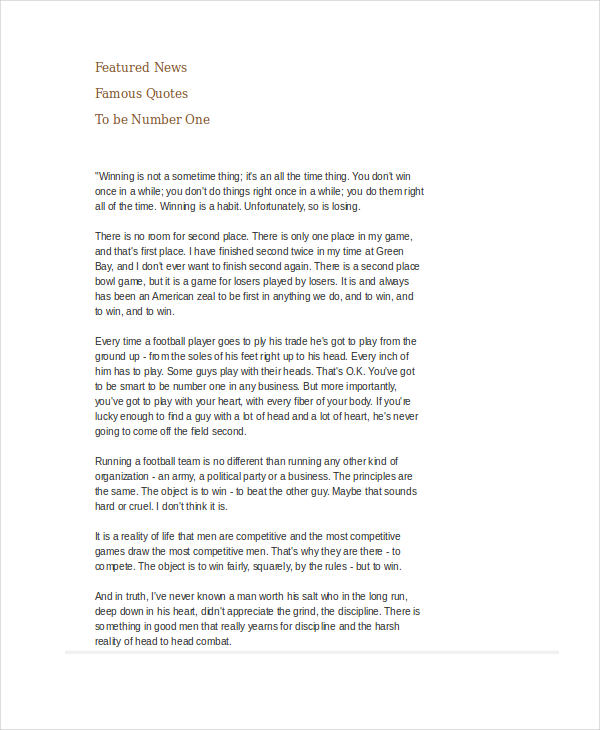
Wedding Speech
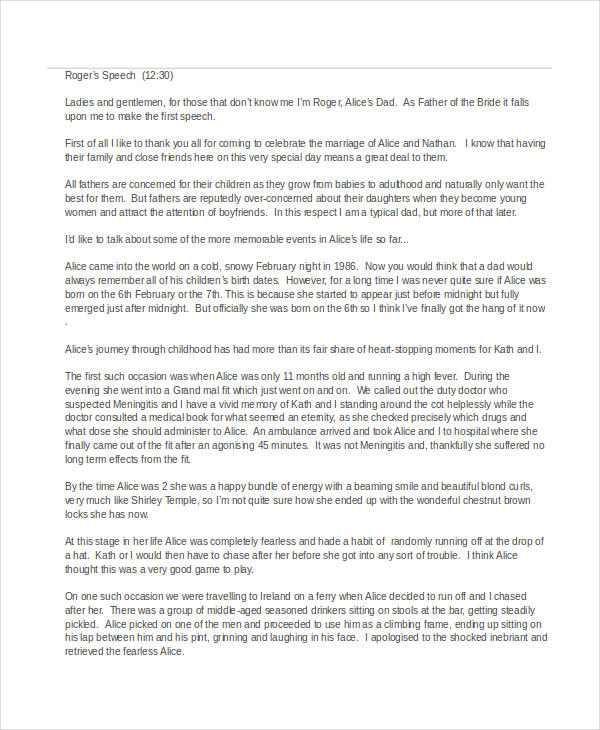
witblitz.net
Groom Wedding Speech
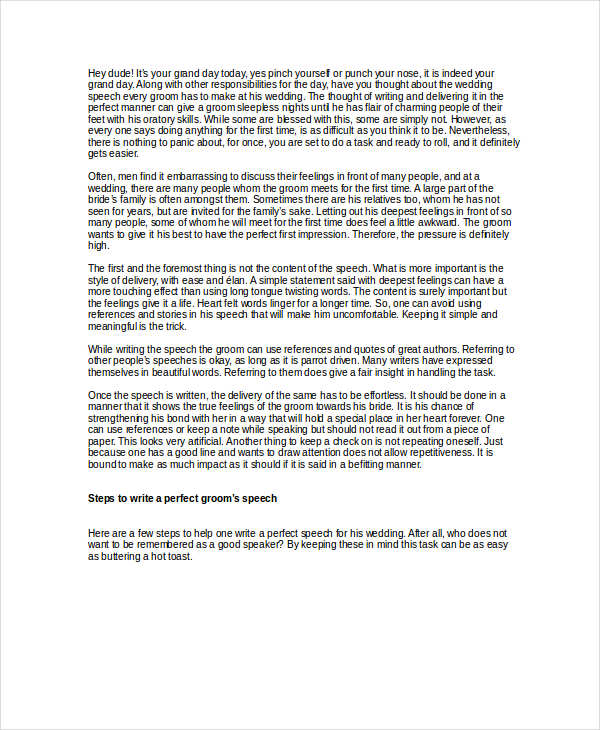
showmesomemoney.com
Size: 239 kB
What is the Purpose of a Speech?
A speech is generally given to satisfy the following points:
1. Informational
Most speeches are about providing more information about a certain topic or subject. These types of speeches are closely related to lectures but are shorter in nature and provide a brief discussion regarding main points of a topic or subject. You may also see speech examples for students .
2. Persuasive
Sales presentations and demonstrations are the type of speeches that aim to entice the audience into taking the desired action after the persuasive speech . Most sales and marketing personnel make use of such speeches with the aim of having the listeners purchase a product or service.
3. Entertainment
Some presentation speeches are made to serve as form of entertainment during functions or events. An example to such are those speeches on weddings or speech intermissions during programs.
4. Inspirational
Inspirational speeches, often delivered during graduations, sermons, and notably in wedding speeches , are crafted to touch the hearts of listeners and motivate them. Their core purpose is to uplift, instill hope, and encourage resilience in facing life’s challenges, whether they seem insurmountable or not. These speeches serve as a beacon of inspiration, guiding individuals to overcome obstacles and find strength in everyday struggles, making them a cherished element of special occasions.
Elevator Speech Examples
Elevator speech for college.
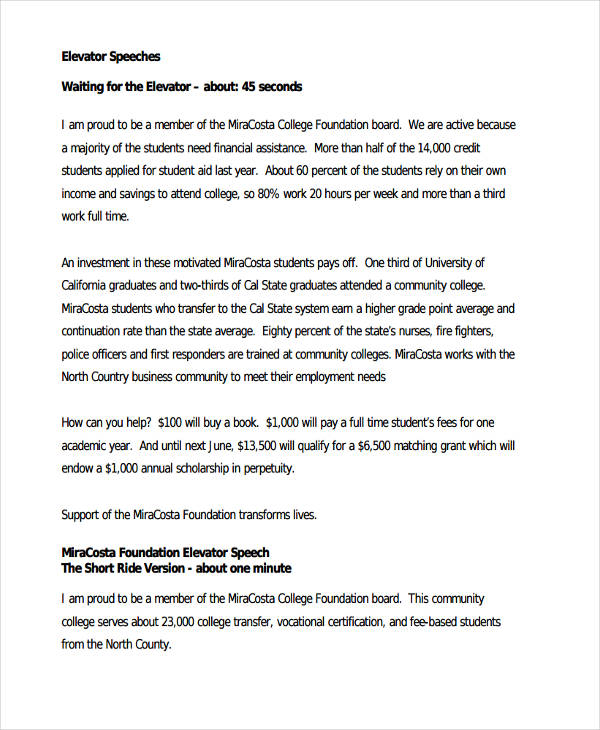
foundation.miracosta.edu
Size: 12 KB
Personal Elevator Speech

gspia.pitt.edu
Size: 210 KB
Leadership Speech
Leadership skills speech.
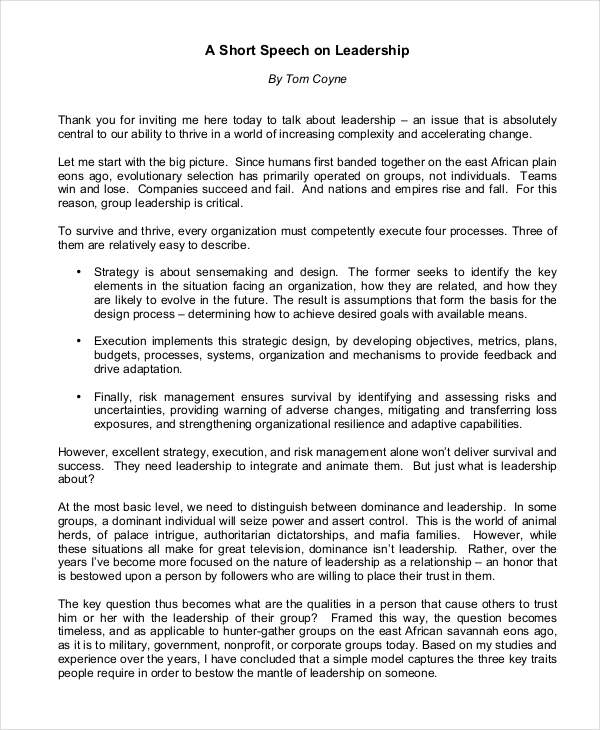
tomcoyne.org
Size: 66 kB
Presentation Speech Example
Award presentation speech.

greekfilmfestchicago.org
Size: 287 kB
Thank You Speech
Wedding thank you.
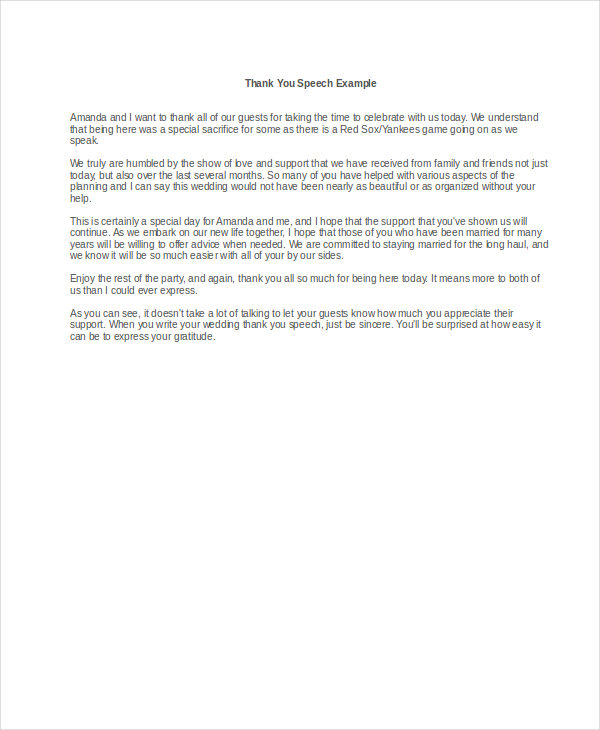
thank-you-notes.com
Formal Thank You Speech Outline

find-the-words.com
Award Thank You
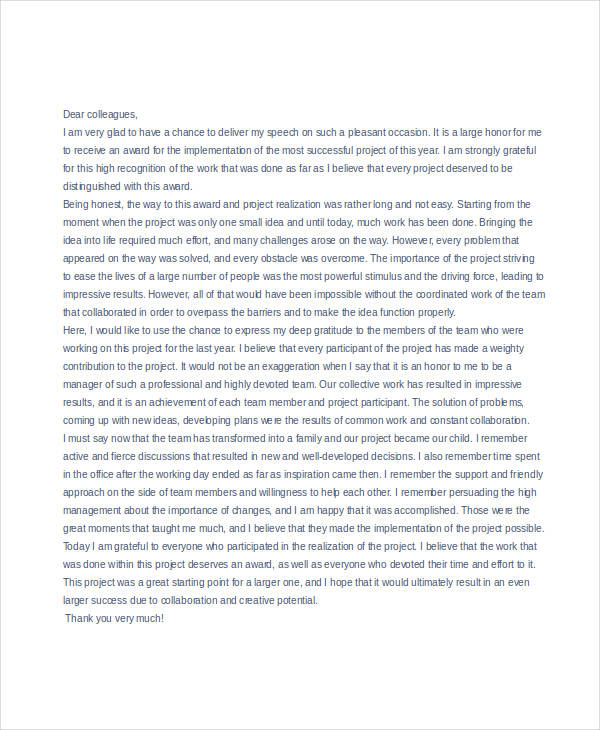
thepensters.com
Benefits of Speech
Constant exposure and practice in making and delivering speeches produces many benefits and gains to an individual such as the following:
1. Self Esteem
Being exposed to public speaking boosts confidence in your self and in your skills. In fact, speech therapy is recommended for people having issues fitting in society or getting along with people.
2. Self Expression
Self introduction speech provide a venue for an individual to express their opinion and ideas about a chosen topic or subject. This also makes others aware of what that individual feels or thinks about the topic or subject.
3. Personal Development
Writing and delivering speeches eventually increases your knowledge of persuasive strategies and in organizing thoughts for a certain topic or subject improving your critical thinking abilities. You may also see farewell speech examples .
4. Personal Evaluation
Being able to speak in public helps an individual gauge his communication skills and get ideas on how to improve them.
5. Network Connections
Through speaking engagements, an individual can vastly improve connections whether for his personal, social, or professional goals. You may also like dedication speech examples .
6. Career Advancement
Delivering speeches gets the attention of management specially if an individual is adept and skillful at doing so. A good speaker is in turn a good motivator and leader.
effective speech-making is a skill that combines thorough preparation, engaging content, and confident delivery. For a deeper understanding of how to structure a speech, including the introduction, body, and conclusion, the Grand Valley State University Speech Lab provides a helpful guide here. This resource can assist in crafting speeches that are coherent, impactful, and memorable.
Text prompt
- Instructive
- Professional
Write a Speech on the importance of community service.
Create a Speech about the power of positive thinking.

IMAGES
COMMENTS
This type of outline is very detailed with all the main points and subpoints written in complete sentences. Your bibliography should be included with this outline. Sample Speech Speaking Outline This type of outline is very brief and uses phrases or key words for the main points and subpoints. This outline is used by the speaker during the speech.
Sample speech outline: how to outline a speech effectively - guidelines, with examples. Plus, a printable blank outline to download.
Master the art of public speaking with our step-by-step guide on crafting a compelling speech outline that engages and persuades your audience.
Before you even begin writing a speech, you need a speech outline. But how do you do that? Here is how you can write the outline of a speech.
A speech outline gives you a map of the key ideas of a successful speech. Learn how to create a clear introduction, main ideas, and a conclusion.
What is an informative speech and how to prepare for its delivery the right way? First, construct the template and look through our examples to get you all set.
The previous article in the Speech Preparation Series described how to select your speech topic and your core message. This article describes how to support your core message with a speech outline, and provides numerous examples. This is the second step in the six-step speech preparation process.
Master the art of crafting a speech outline with our helpful tips and examples. Enhance your public speaking skills with our blog.
What's on this page: How to plan a speech step by step: gathering the information to write your speech brainstorming: what is a brainstorm, examples of brainstorms, getting started, with full step by step explanations and examples how to shape material to fit an audience, the speech setting, and time allocation an example speech outline
A step by step guide for writing a great speech. Learn how to engage your audience from start to finish. With examples and a printable speech outline.
A speech outline can increase your confidence and help you keep your place so you sound authoritative and in control. As you write your speech outline, focus on how you'll introduce yourself and your topic, the points you'll cover, and the interests of your audience.
Are you going through the painstaking process of speech writing? Crafting an outline of speech can quickly simplify this meticulous task! Allow us to help.
What is the purpose of persuasive speech and how to prepare for its delivery? Discover how to outline it the right way (with examples) for successful results.
Learn how to structure and deliver a persuasive speech with examples and tips from VirtualSpeech, a platform that provides AI-powered soft skills training.
43 Informative Speech Outline Templates & Examples Are you looking for ways to make your informative speech interesting? There are multiple ways through which you can make it sound interesting to your audience. If you are a student, you may have to write such kind of speeches every now and then. Besides students, business owners also have to come up with such kind of speeches for their ...
Basic Speech Outline Just like any other piece of writing, you have to make do with an outline to draft your speech. The purpose of this outline is to act as a blueprint for your subsequent presentations. It does this by highlighting the key elements of the speech.
For example, replace "Suppor-ng Idea #1" with a sentence that introduces your first suppor-ng idea for that Main Idea. Remember, this is a full-sentence outline. Each numeral or leHer of the outline should be followed by a full sentence. Finally, remember this is only a template. It is flexible.
Learn the definition of a speech outline. Discover how to write formal types of speech outlines such as informative and persuasive outlines. See...
How can you make your next speech more persuasive? Try using a speech outline. Learn the tips you need to create an effective outline.
This article will introduce readers to such a speech and discuss the basic components of the outline for creating it. It also provides best practices for preparing this speech and examples you can use as a reference to better understand how to structure these.
Discover powerful storytelling speech examples that will captivate your audience, evoke emotions, and leave a lasting impact. Learn how to craft compelling narratives today!
The outline for a public speech, according to COMM 101 online textbook The Public Speaking Project, p.p. 8-9.
Use this outline to teach students in upper elementary, middle school, and high school how to write an organized speech. This step-by-step guide is perfect for introducing students to public speaking.
Speech refers to the expression of thoughts and feelings through spoken language. It is the act of talking and communicating verbally with others, using words to convey ideas, information, or emotions. Speech can range from everyday conversation to formal presentations and public speaking.